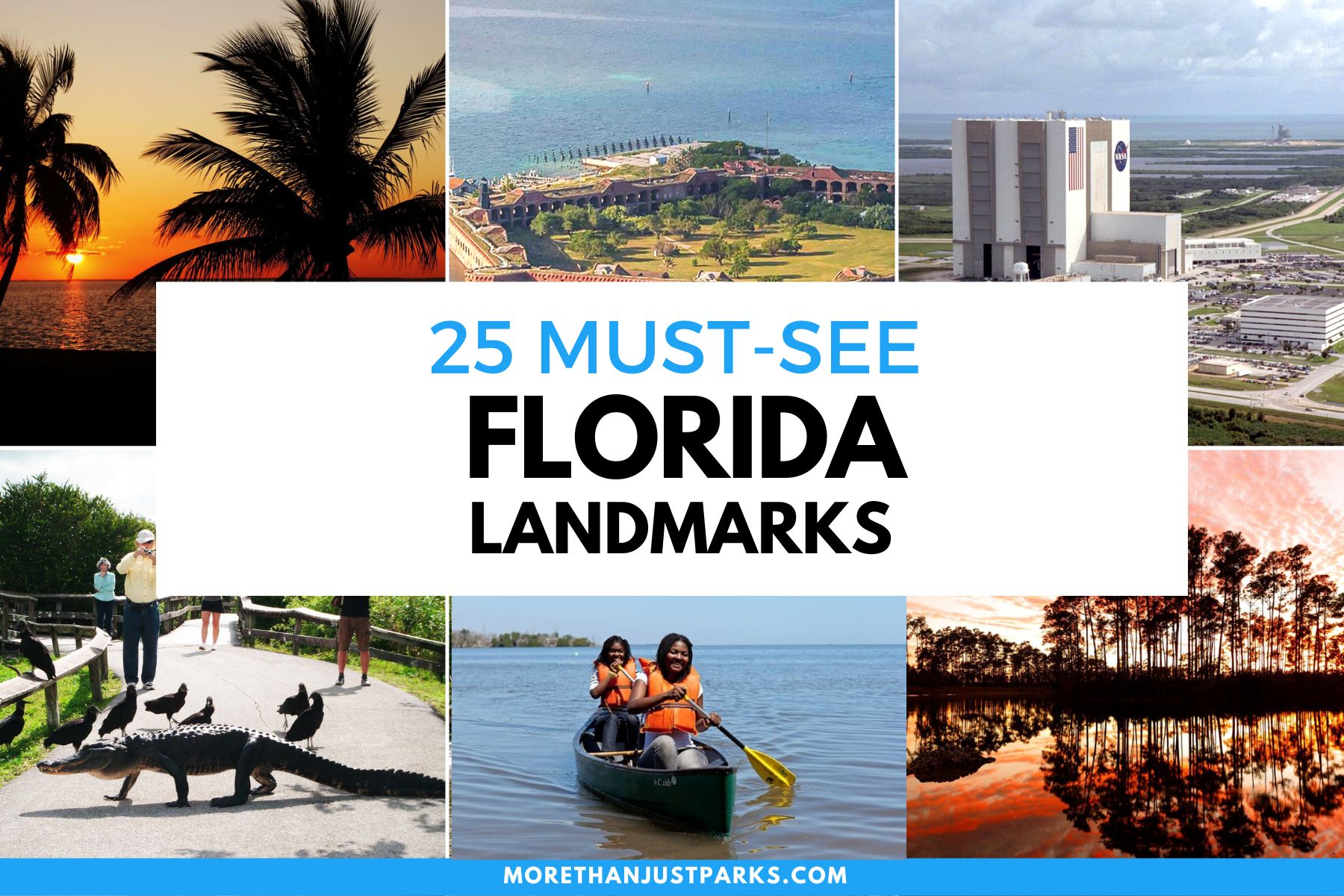
Article Summary: Florida Landmarks
Florida Landmarks. More Than Just Parks has 25 incredible must-see sites for you to visit.
There’s so much more to this exciting place than the Walt Disney World. In this article, we’ll familiarize you with the incredible landmarks located in the Sunshine State.
We’ve got incredible places, iconic memorials, fascinating museums, epic monuments and so much more.
We’re going to give you our list of the Top 25 Landmarks In Florida.
So, What Is A Landmark?
Well, it’s a place of “a special character or special historical or aesthetic interest or value as part of the development, heritage, or cultural characteristics of a city, state, or nation.”
Why visit these places? Because landmarks connect us to the past. Through visiting these wonderful places where history occurred we find our roots. It allows us to feel like we are a part of something much bigger than ourselves.
And, speaking of history, did I mention that I taught the subject? I spent a lifetime teaching about the history behind many of these amazing sites. Then I got to see them firsthand. And now I’m sharing the fascinating stories of these places with you. It doesn’t get any better than that!
So, without further ado, let’s dive in.
Table Of Contents
Florida Landmarks
Some Fascinating Facts About Florida
Here are some interesting facts about Florida:
- Florida is known as the “Sunshine State” because it receives an average of 230 days of sunshine per year.
- It is the southernmost state in the continental United States.
- Florida is the fourth most populous state in the country, with a population of over 21 million people.
- The state capital is Tallahassee, but the largest city is Jacksonville.
- Florida is home to Disney World, Universal Studios, and other major theme parks, making it a top tourist destination.
- The state is famous for its beautiful beaches, such as Miami Beach, Clearwater Beach, and Siesta Key Beach.
- The Everglades National Park in Florida is the largest subtropical wilderness area in the United States and is home to a diverse array of wildlife.
- Florida is the only state in the country that borders both the Atlantic Ocean and the Gulf of Mexico.
- Florida is home to many species of reptiles, including alligators, crocodiles, and snakes.
- The Florida Keys, a chain of islands off the southern coast of Florida, are known for their beautiful coral reefs and are popular for diving and snorkeling.
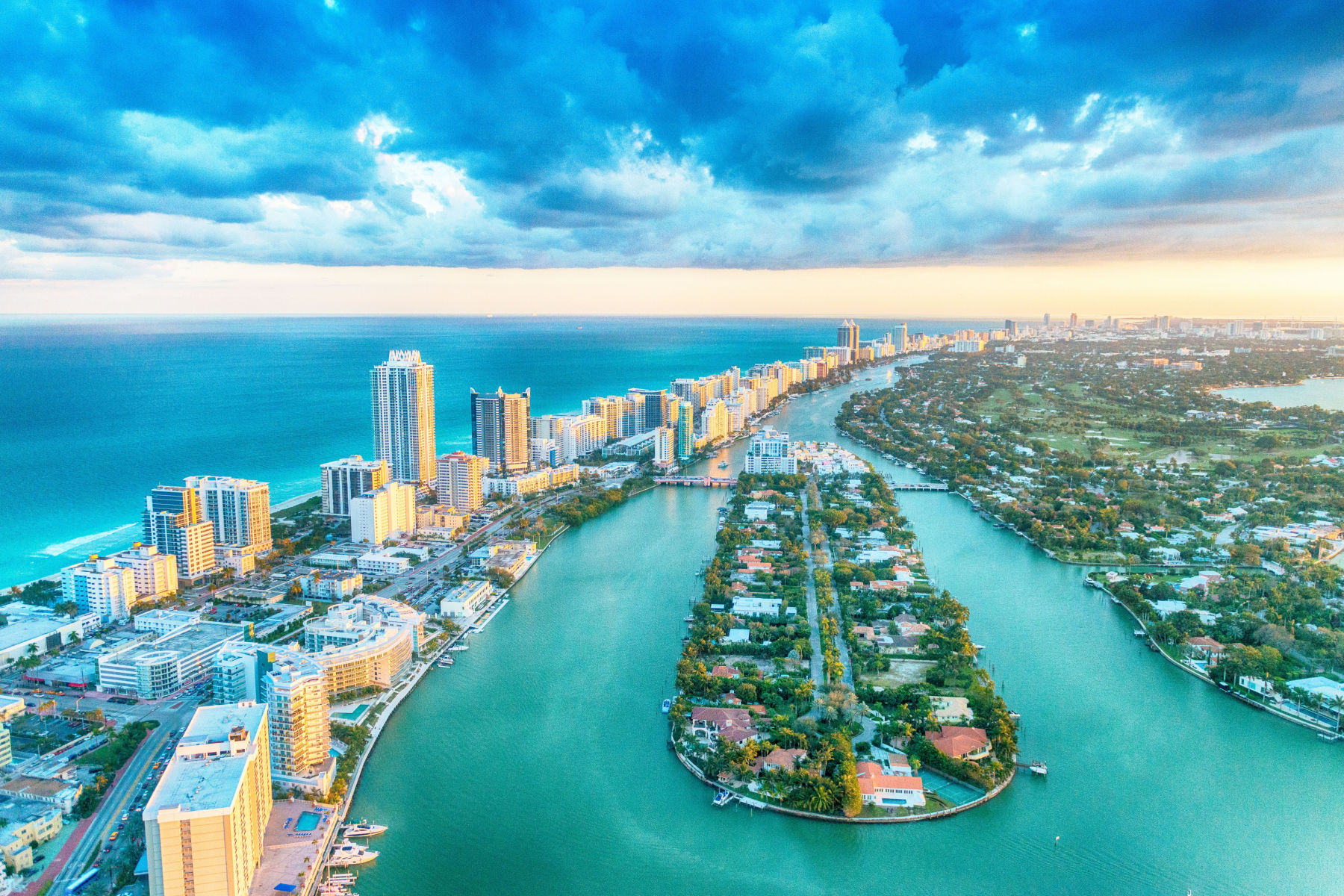
We’re Excited To Share Our List Of The Top 20 Florida Landmarks With YOU
Florida is the boating and fishing capital of the world. It has more than 7,700 lakes, 11,000 miles of rivers, 2,276 miles of tidal shoreline, and has produced more than 900 world fishing records, more than any other state, or country. Florida has more than 700 freshwater springs.
It’s also home to some truly amazing landmarks. More Than Just Parks is excited to share our list of the Top 25 Florida Landmarks with you. And we’re kicking it off at #25 with Fort King National Historic Landmark.

Top 25 Florida Landmarks
25. Fort King National Historic Landmark
Fort King National Historic Landmark is located in Ocala, Florida and was a significant military outpost during the Second Seminole War in the mid-19th century.
The fort was originally established in 1827 and named after Colonel William King, who was killed during the First Seminole War. It was built to protect settlers and travelers in the area and to serve as a base for military operations against the Seminole Indians.

Fort King NHL plaque | Courtesy of Wikimedia Commons
The Second Seminole War
In 1835, tensions between the Seminole Indians and the U.S. government escalated into the Second Seminole War. The fort played a key role in the conflict, serving as a staging ground for troops and supplies and as a refuge for civilians during the fighting.
In 1836, the fort was attacked and burned down by Seminole warriors. A new fort was built on the site in 1837, and it remained in use until the end of the war in 1842.
After the war, the fort was abandoned and fell into disrepair. In the 20th century, efforts were made to preserve and restore the site. In 1962, Fort King was designated a National Historic Landmark.
Today, the site includes a reconstructed fort and visitor center, as well as trails and interpretive exhibits that tell the story of the fort’s history and its significance in the Second Seminole War.
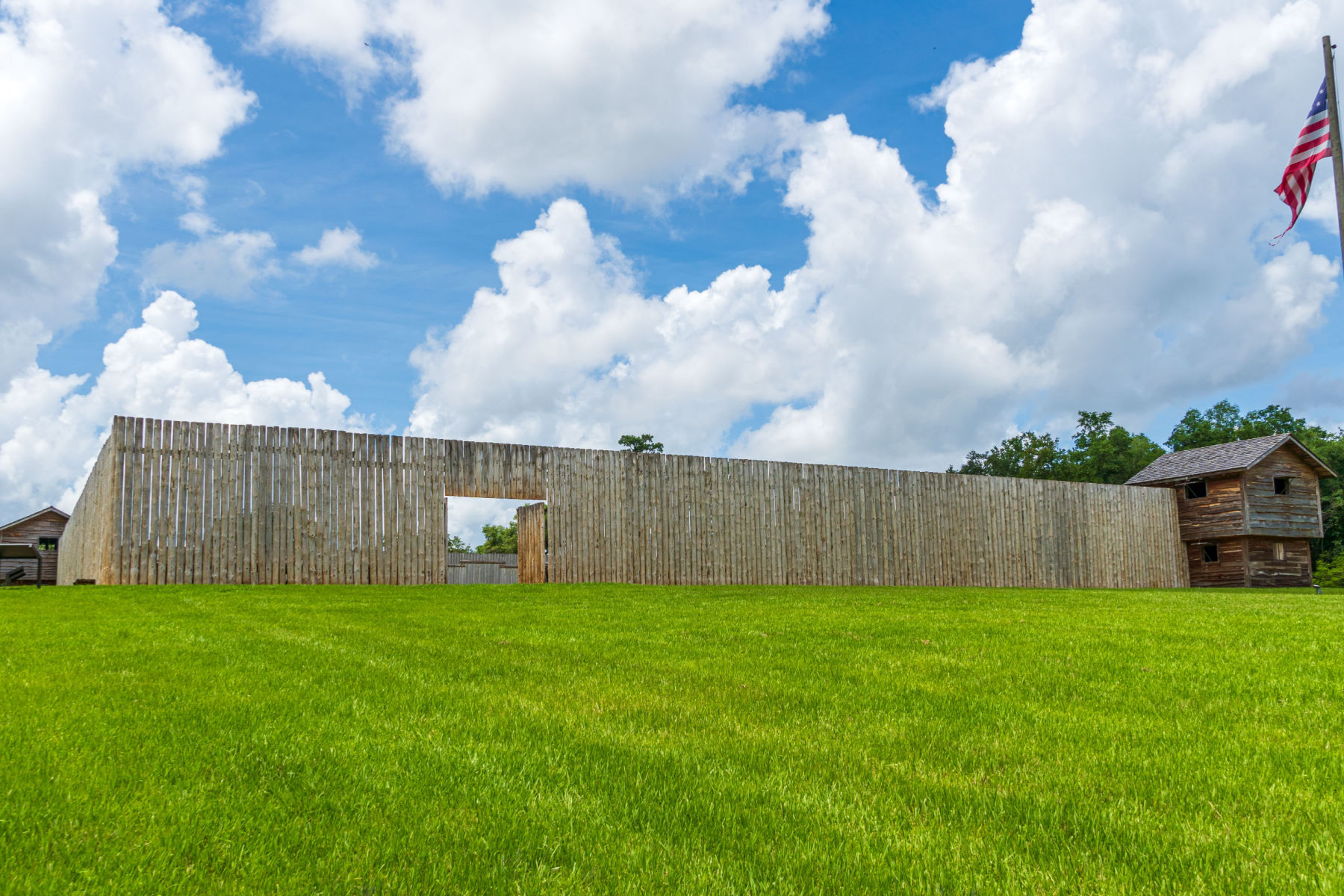
24. Lightner Museum
Our next Florida landmark was built by railroad tycoon and hotel developer Henry Flagler and is a magnificent example of Spanish Renaissance architecture. At #24 on our list of the Best Florida Landmarks is the Lightner Museum.
The Lightner Museum is located in St. Augustine, Florida, and is housed in the former Alcazar Hotel, a magnificent Spanish Renaissance Revival-style building. The museum was established in 1948 by Otto C. Lightner, a publisher and collector, who donated his extensive collection of art, antiques, and curiosities to the city.
The Lightner Museum is renowned for its eclectic collection of decorative arts, including furniture, glass, porcelain, silver, and cutlery from the 19th and 20th centuries. The museum also has an impressive collection of fine art, with works by notable artists such as William-Adolphe Bouguereau, Thomas Sully, and John Singer Sargent.
The museum’s main gallery, located in the former hotel’s indoor swimming pool, is one of its most stunning features. The gallery is surrounded by balconies with ornate wrought-iron railings, and the pool is now a reflecting pool filled with plants and sculptures.
Other highlights of the Lightner Museum include the Victorian Science and Industry Room, which showcases inventions and scientific instruments from the Victorian era, and the Music Room, which features a collection of rare musical instruments, including pianos, harps, and organs.
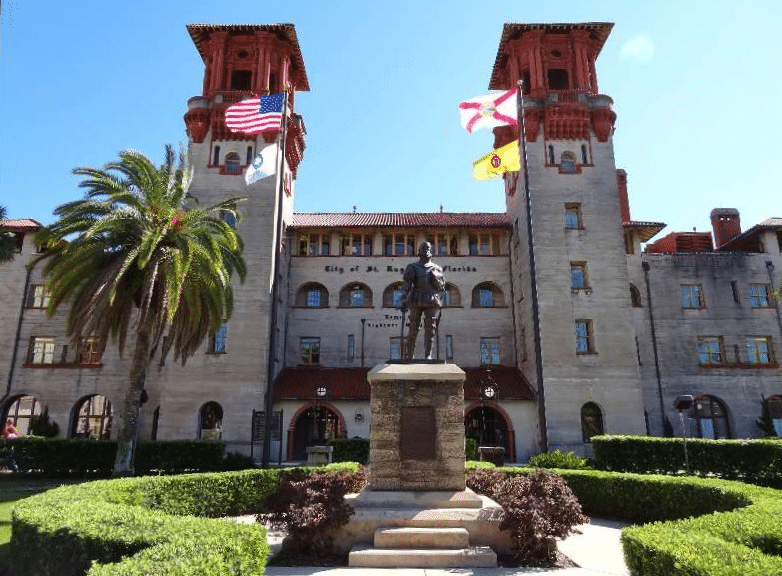
23. Okeechobee Battlefield State Historic Park
Our next Florida landmark keeps alive one of the greatest tales of the Second Seminole War. The battle, which occurred on Christmas Day in 1837, is reenacted annually on the last weekend in February. At #24 on our list of the Best Florida Landmarks is the Okeechobee Battlefield State Historic Park.
The Okeechobee Battlefield is the site of a significant battle that took place on December 25, 1837, during the Second Seminole War. The battle occurred near Lake Okeechobee in Florida and pitted the United States Army against the Seminole Tribe.
The Seminole Wars were a series of conflicts between the Seminole people and the United States government, which lasted from 1817 to 1858. The Second Seminole War, which began in 1835, was one of the longest and most costly of these conflicts. It was fought over the issue of Indian removal and the forced relocation of Seminole people from Florida to Indian Territory (present-day Oklahoma).
The Battle of Okeechobee was a significant engagement of the Second Seminole War. The United States Army, under the command of General Zachary Taylor, sought to defeat a large Seminole force led by Chief Alligator. Taylor’s army consisted of about 800 soldiers, while the Seminole force numbered around 380 warriors.

Seminole Indians | Courtesy of Wikimedia Commons
The Seminole Warriors Launched A Surprise Attack
The battle began early in the morning of December 25, 1837. The Seminole warriors launched a surprise attack on Taylor’s army, which was crossing a swampy area near Lake Okeechobee. The fighting was fierce and lasted for several hours. The Seminole warriors used guerrilla tactics, attacking and then retreating into the dense vegetation of the surrounding swamps.
Despite heavy casualties on both sides, the United States Army emerged victorious. The Seminole warriors retreated, and the army continued its march southward. The battle was significant because it demonstrated the Seminole’s ability to resist American military power and highlighted the difficulty of fighting a guerrilla war in the dense, swampy terrain of Florida.
Today, the Okeechobee Battlefield is a National Historic Landmark and is open to the public. The site includes a small museum, walking trails, and a monument to the soldiers who fought in the battle. The area around Lake Okeechobee remains an important part of Seminole history and culture, and the battle is remembered as a key moment in the struggle for Seminole independence and sovereignty.

22. The Ernest Hemingway Home & Museum
At #22 on our list of the Best Florida Landmarks is a place which celebrates a literary legend. It’s the Ernest Hemingway Home & Museum.
He’s one of the greatest writers of all time and you can learn about him at The Ernest Hemingway Home & Museum, also known as the Hemingway House. It’s located in Key West, Florida, and is a National Historic Landmark.
The house was built in 1851 in the Spanish Colonial style and was originally owned by a wealthy maritime merchant named Asa Tift.
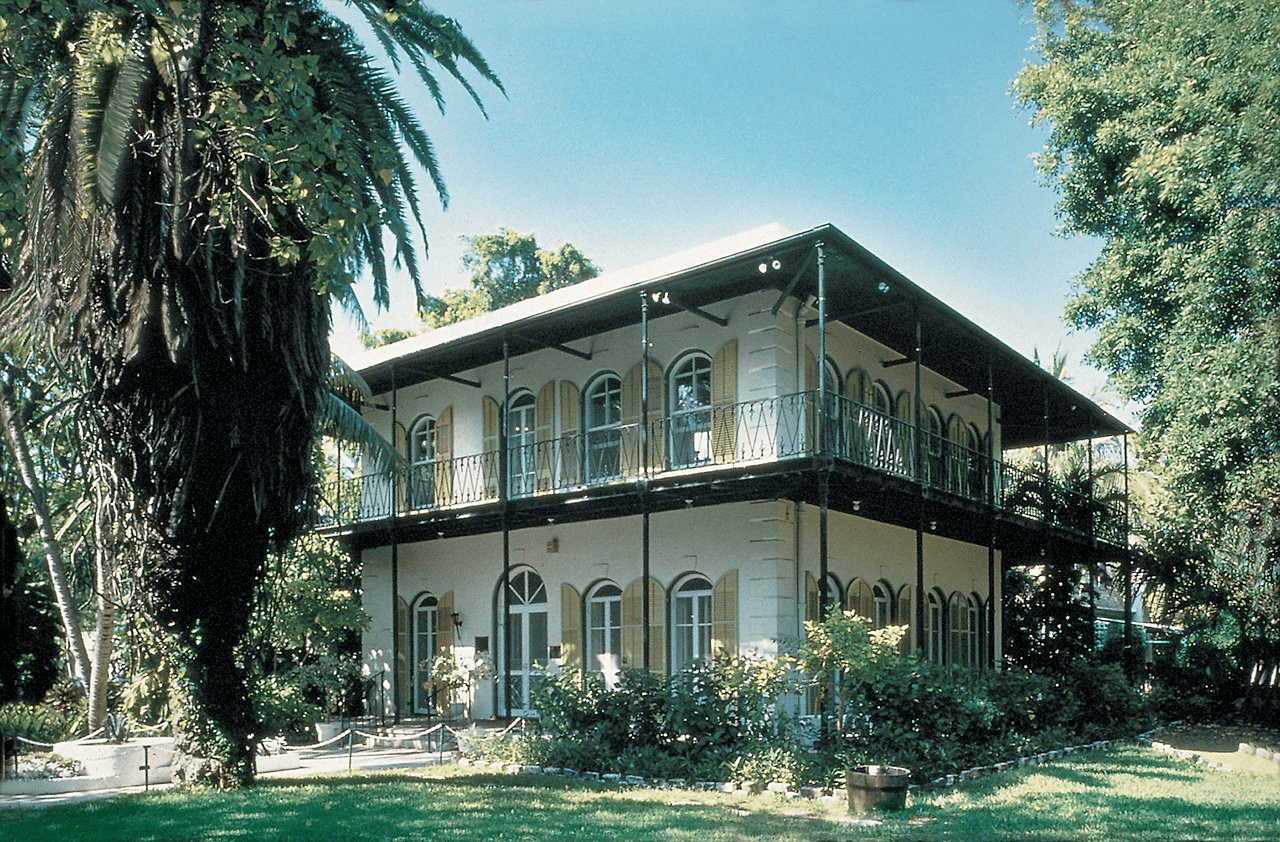
Ernest Hemingway
Ernest Hemingway, one of America’s most famous authors, purchased the house in 1931, along with his wife Pauline. The Hemingways lived in the house for almost a decade, during which time Hemingway wrote some of his most famous works, including “To Have and Have Not” and “The Snows of Kilimanjaro.”
Hemingway was known to have been very fond of Key West, and he wrote about the island’s laid-back lifestyle and colorful characters in many of his stories.
After Hemingway’s death in 1961, the house was left to his wife, who sold it to a local businessman. In 1968, a group of concerned Key West residents formed the Hemingway Home Foundation with the goal of purchasing the property and preserving it as a museum.
The foundation was successful in its efforts, and the house was opened to the public in 1968.

Ernest Hemingway typewriter | Courtesy of Wikimedia Commons
Things To Do
Here are some things you can do when you visit:
- Take a guided tour of the house: You can explore the beautifully restored Spanish Colonial mansion and learn about the history and architecture of the building. You’ll also learn about Hemingway’s life and work, and see where he wrote some of his most famous novels.
- Visit the museum exhibits: The museum features a variety of exhibits on Hemingway’s life and work, including artifacts, manuscripts, and photographs. You can learn about his time in Key West and his travels around the world.
- See the famous six-toed cats: Hemingway was an avid cat lover and owned several six-toed cats. Today, the house is home to over 40 cats, many of which are descendants of Hemingway’s original cats.
- Explore the gardens and grounds: The house is surrounded by beautiful gardens and landscaped grounds that are open to visitors. You can take a leisurely stroll or have a picnic on the lawn.
- Visit the gift shop: The gift shop offers a wide selection of books, souvenirs, and gifts related to Hemingway and the house.
- Attend a special event: The museum hosts a variety of special events throughout the year, including book signings, lectures, and literary festivals.
- Have a drink at the Hemingway-inspired bar: The house has a bar named after Hemingway, where you can enjoy a cocktail and soak up the atmosphere.
- Visit nearby attractions: The Hemingway Home & Museum is located in the heart of Key West, which is home to many other cultural attractions, shops, and restaurants.
21. Vizcaya Museum & Gardens
Our next Florida landmark is a lasting, gorgeous structure of European essence. Overlooking the pristine waters of Biscayne Bay, this beautiful estate offers a refreshing serenity to the otherwise extravagant and flashy rhythm of Miami.
At #21 on our list of the Best Florida Landmarks is the Vizcaya Museum & Gardens.
The Vizcaya Museum & Gardens is a historic estate located in Miami, Florida. The estate was built in the early 20th century by James Deering, a wealthy businessman and art collector who wanted to create a Mediterranean-style villa on the shores of Biscayne Bay.
Construction of the estate began in 1914 and was completed in 1916. The villa, which has 34 rooms, features a mix of architectural styles, including Italian Renaissance, Baroque, and Rococo. The interior of the villa is decorated with art and antiques collected by Deering during his travels throughout Europe.

View across some of the gardens at Vizcaya Museum and Gardens | Courtesy of Wikimedia Commons
The Estate Includes 10 Acres Of Formal Gardens
In addition to the villa, the estate includes 10 acres of formal gardens designed in the Italian Renaissance style. The gardens feature fountains, sculptures, and a maze of hedges. The estate also includes a breakwater, a boathouse, and a village with staff quarters, stables, and a dairy.
After James Deering’s death in 1925, the estate was sold to a group of developers who planned to demolish the villa and subdivide the property. However, a group of concerned citizens formed the Vizcaya Preservation Association and successfully lobbied the city of Miami to purchase the property and preserve it as a museum.
Today, the Vizcaya Museum & Gardens is a popular tourist attraction that showcases the opulence and grandeur of the Gilded Age. Visitors can tour the villa and gardens and view the collection of art and antiques that James Deering collected during his lifetime.
The estate also hosts a variety of cultural events, including concerts, lectures, and special exhibits.
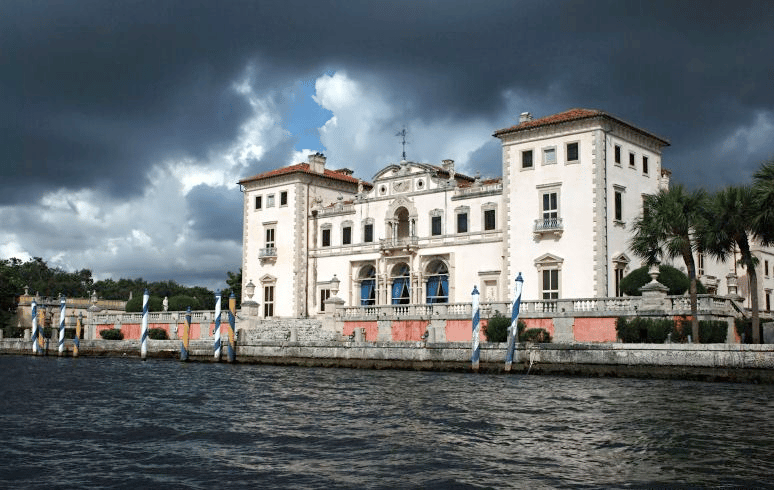
Top 20 Florida Landmarks
20. Kingsley Plantation
We’re on to our list of the Top 20 Florida Landmarks. Our next site is an antebellum plantation with a fascinating story to tell. At #20 on our list of the Best Florida Landmarks is the Kingsley Plantation.
The Kingsley Plantation is a historic site located on Fort George Island in Jacksonville, Florida. The plantation was founded in the late 18th century by Zephaniah Kingsley, a slave trader and planter who owned hundreds of enslaved Africans.
The main house on the plantation, known as the Kingsley House, was built in 1797 and is one of the oldest standing plantation houses in Florida. The house is made of tabby, a type of concrete made from crushed oyster shells, sand, and water.

Kingsley Plantation Kitchen | Courtesy of Wikimedia Commons
A Distinctive Architectural Style
The Kingsley House features a distinctive architectural style known as the “Georgian-Colonial,” which combines elements of both Georgian and Colonial architecture.
In addition to the main house, the Kingsley Plantation includes several other buildings, including a kitchen house, a barn, and several slave quarters. The slave quarters are some of the best-preserved examples of slave housing in the southeastern United States.
Today, the Kingsley Plantation is managed by the National Park Service and is open to the public for tours. The site offers a glimpse into the history of slavery and the lives of the enslaved Africans who lived and worked on the plantation.
Visitors can explore the Kingsley House and other historic buildings, as well as hike the nature trails that wind through the surrounding salt marshes and forests. The site also hosts a variety of educational programs and cultural events throughout the year.
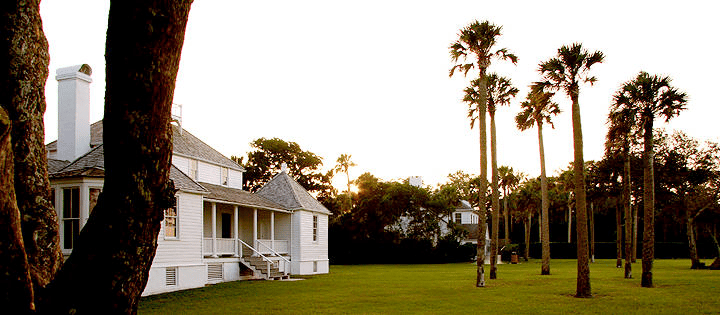
19. Key West Lighthouse
Our next Florida landmark was built in 1825 to help the many ships entering the port avoid the hazardous reefs. Today, you can climb the 88 iron steps to the top of the tower for a scenic look at what the lighthouse keepers watched over for more than 120 years.
At #19 on our list of the Best Florida Landmarks is the Key West Lighthouse.
The lighthouse has played an important role in the maritime history of the United States, serving as a beacon for ships in the Gulf of Mexico for over 150 years.
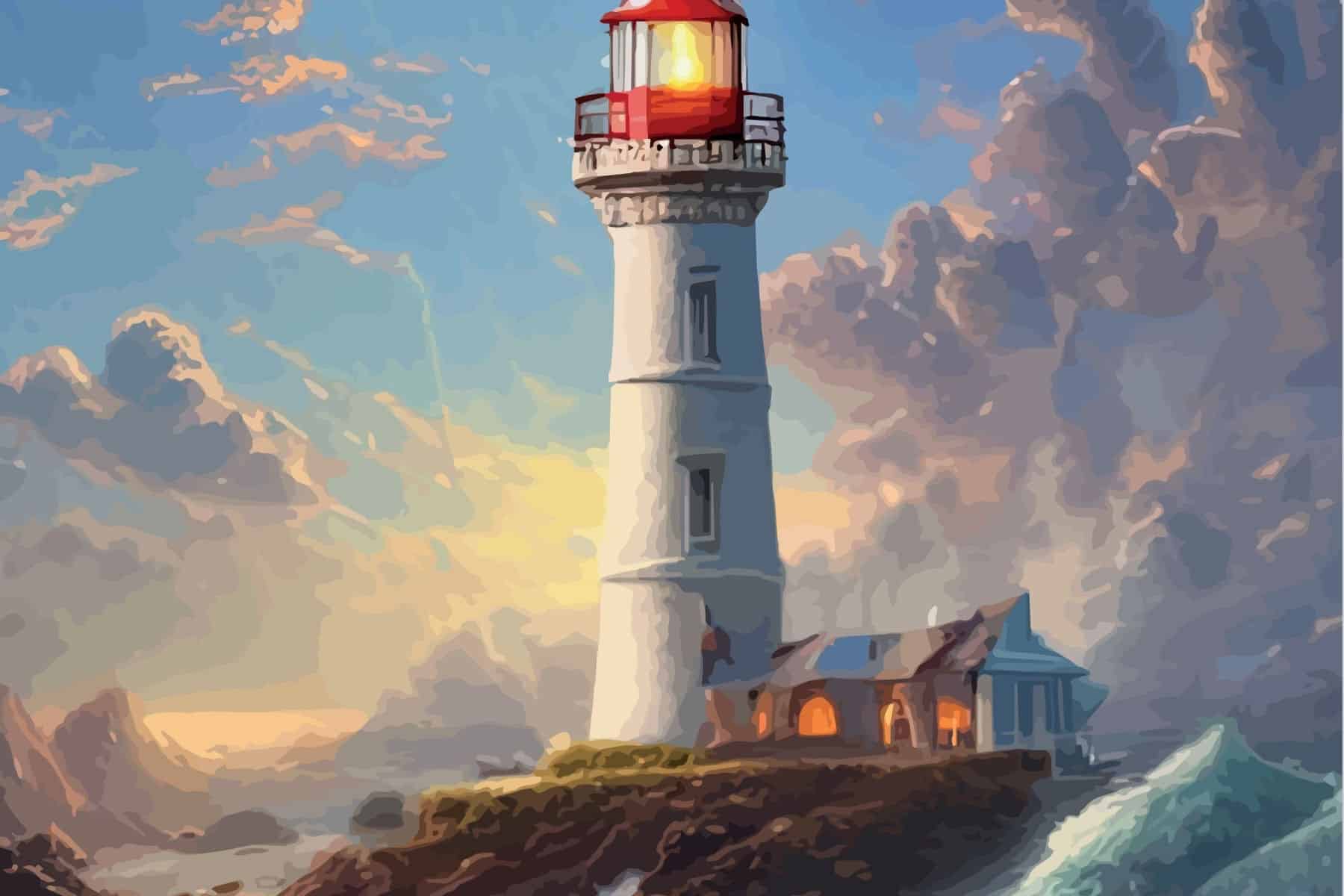
Constructed To Guide Ships Through The Dangerous Waters
Construction on the Key West Lighthouse began in 1825, and the lighthouse was completed and lit in 1826. The original lighthouse was a 65-foot tall tower made of coral rock and was topped with a fixed white light that could be seen from a distance of about 14 miles.
The tower was constructed to guide ships through the dangerous waters of the Florida Keys, which were notorious for shipwrecks due to the treacherous reefs and shallow waters.
Over the years, the Key West Lighthouse underwent several changes and renovations. In 1846, the tower was raised to its current height of 86 feet, and a new third-order Fresnel lens was installed.
The lens was manufactured in France and was considered to be one of the most advanced lighthouse lenses of its time. The lens was capable of producing a bright, focused light that could be seen from up to 17 nautical miles away.
The Key Lighthouse During The Civil War
During the Civil War, the Key West Lighthouse played a vital role in the Union blockade of Confederate ports in the Gulf of Mexico. The lighthouse was used to guide Union ships through the shallow waters and treacherous reefs, and it helped to prevent Confederate ships from entering or leaving the port of Key West.
In 1969, the Key West Lighthouse was decommissioned and replaced by a modern automated beacon. The lighthouse was then acquired by the Key West Art and Historical Society, which restored the tower and opened it to the public as a museum in 1992.
Today, visitors to the Key West Lighthouse can climb the 88 steps to the top of the tower and enjoy panoramic views of the island and the Gulf of Mexico. The museum also features exhibits on the history of the lighthouse, the maritime history of Key West, and the lives of the lighthouse keepers who tended the beacon over the years.
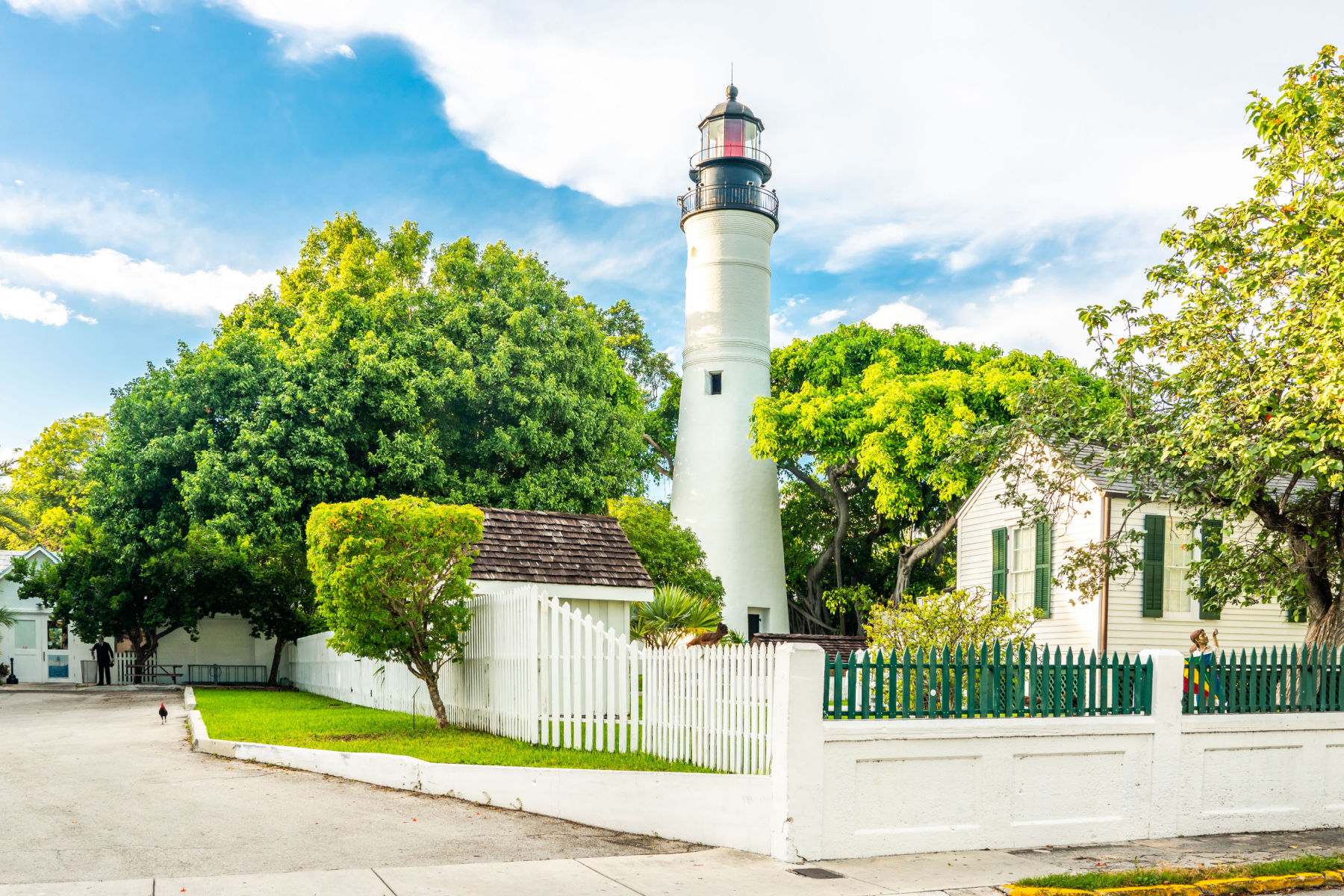
18. Pelican Island National Wildlife Refuge
Our next Florida landmark was created in 1903 to safeguard the last remaining nesting habitat for brown pelicans and other wading birds on America’s East Coast. It also serves to protect endangered and threatened species, and to provide feeding, nesting, and roosting areas for over 130 species of birds.
At #18 on our list of the Best Florida Landmarks is the Pelican Island National Wildlife Refuge.
Pelican Island National Wildlife Refuge is a protected area located on the east coast of Florida, in the Indian River Lagoon. It was the first national wildlife refuge in the United States, established by an executive order signed by President Theodore Roosevelt in 1903. The refuge encompasses a total of 5,376 acres, including the 3-acre Pelican Island, and serves as an important habitat for a variety of endangered and threatened species.
The primary purpose of the Pelican Island National Wildlife Refuge is to provide a protected nesting and feeding habitat for migratory birds, particularly pelicans and other waterbirds. The island itself is a critical nesting area for brown pelicans, which were nearly driven to extinction in the early 20th century due to over-harvesting of their eggs and feathers.
Today, the refuge serves as a model for the conservation of these and other bird species.

Pelican Island National Wildlife Refuge | Courtesy of Wikimedia Commons
The Refuge Consists Of Several Different Habitat Types
The refuge consists of several different habitat types, including mangrove forests, salt marshes, and freshwater wetlands. These diverse habitats support a wide range of other wildlife, including sea turtles, manatees, dolphins, and a variety of fish and invertebrates.
In addition to its importance as a wildlife habitat, the Pelican Island National Wildlife Refuge is also significant for its historical and cultural value. The establishment of the refuge helped to pave the way for the creation of the National Wildlife Refuge System, which now includes over 560 refuges across the country.
Today, visitors to the Pelican Island National Wildlife Refuge can enjoy a variety of recreational opportunities, including hiking, fishing, and wildlife watching. The refuge is also home to the Pelican Island Audubon Society, which offers educational programs and events focused on the conservation of the area’s natural resources.
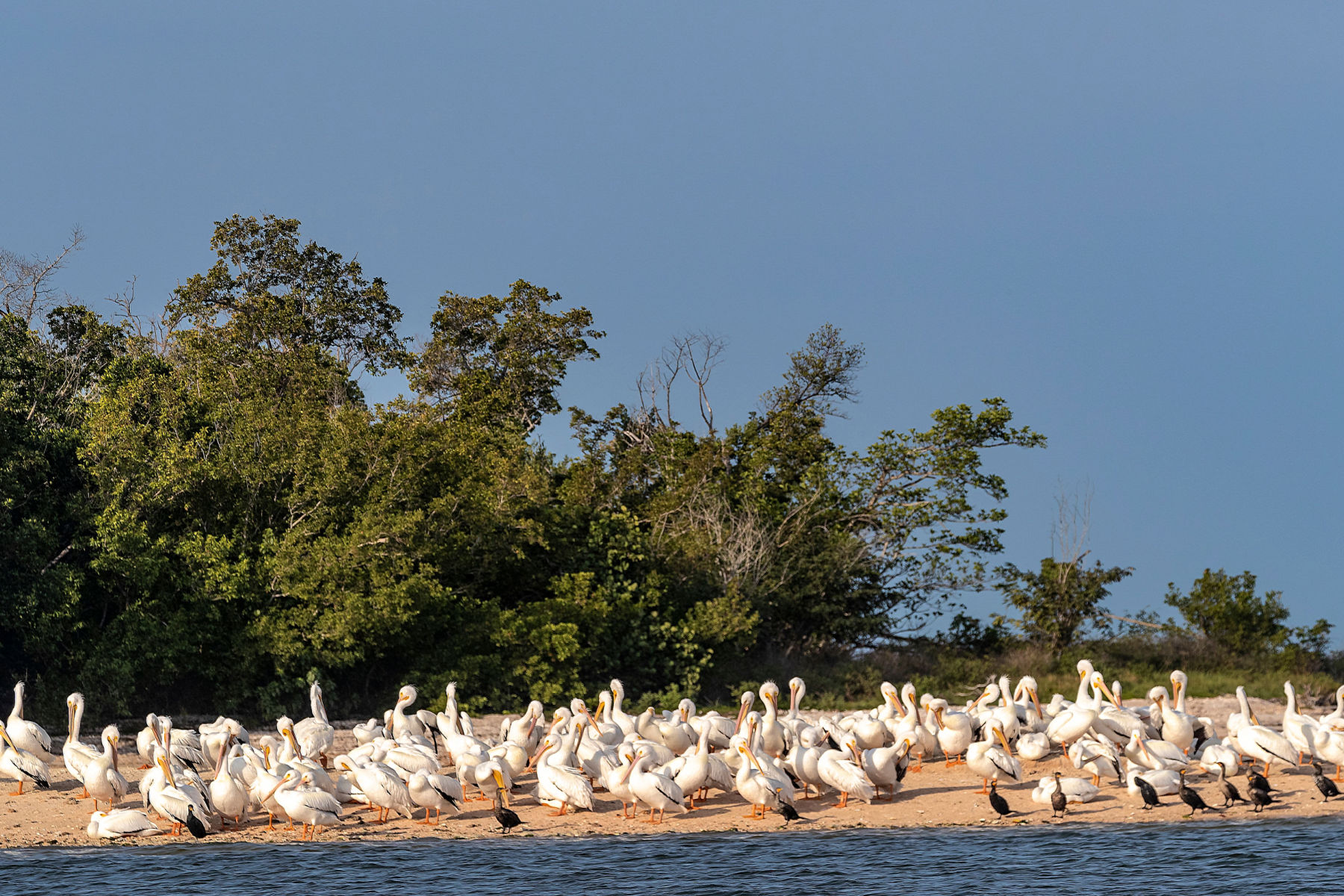
17. Fort Caroline National Memorial
If you love military history then you’ll enjoy our next Florida landmark. It’s Fort Caroline National Memorial.
Fort Caroline National Memorial is located in Jacksonville, Florida. It commemorates the short-lived French attempt to establish a colony in Florida in the 16th century.
In 1562, French explorer Jean Ribault led an expedition to Florida and established a colony at the mouth of the St. Johns River, which he named Fort Caroline in honor of the French King Charles IX. The colony was intended to serve as a base for French piracy and to challenge Spanish claims to the region.
The Spanish, who had already established colonies in Mexico and the Caribbean, saw the French colony as a threat and launched a series of attacks to try to eliminate it. In 1565, the Spanish under Pedro Menéndez de Avilés established their own colony at St. Augustine, just south of Fort Caroline.

The Spanish Launched At Attack On Fort Caroline
In September of 1565, the Spanish launched an attack on Fort Caroline. The French were poorly prepared and were quickly defeated, with many being killed and others taken prisoner. The Spanish then destroyed Fort Caroline and established their dominance in the region.
Fort Caroline was largely forgotten for several centuries, but was rediscovered in the 20th century and designated as a National Memorial in 1950. Today, the site features a replica of the original fort and offers visitors the opportunity to learn about the early European exploration and colonization of Florida.
The National Park Service also manages nearby natural areas, including the Timucuan Ecological and Historic Preserve, which includes wetlands, forests, and other habitats that were home to the Timucua people, who lived in the area long before the arrival of Europeans.
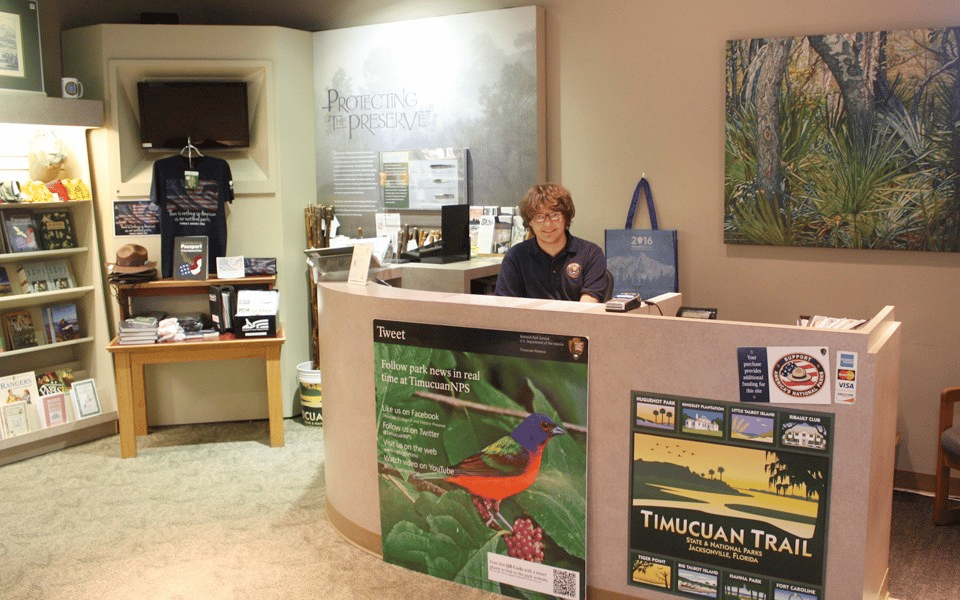
16. De Soto National Memorial
Our next Florida landmark honors the legacy of a famed explorer. At #16 on our list of the Best Florida Landmarks is the De Soto National Memorial.
The De Soto National Memorial is located in Bradenton, Florida. It commemorates the explorations of the Spanish explorer Hernando de Soto and his expedition through the southeastern United States in the early 16th century.
De Soto and his expedition, which consisted of over 600 men, arrived in Florida in 1539, and spent the next four years exploring and searching for gold and other resources.
They traveled through what is now Florida, Georgia, the Carolinas, Tennessee, Alabama, and Mississippi, and were the first Europeans to make contact with many of the native tribes in the region.
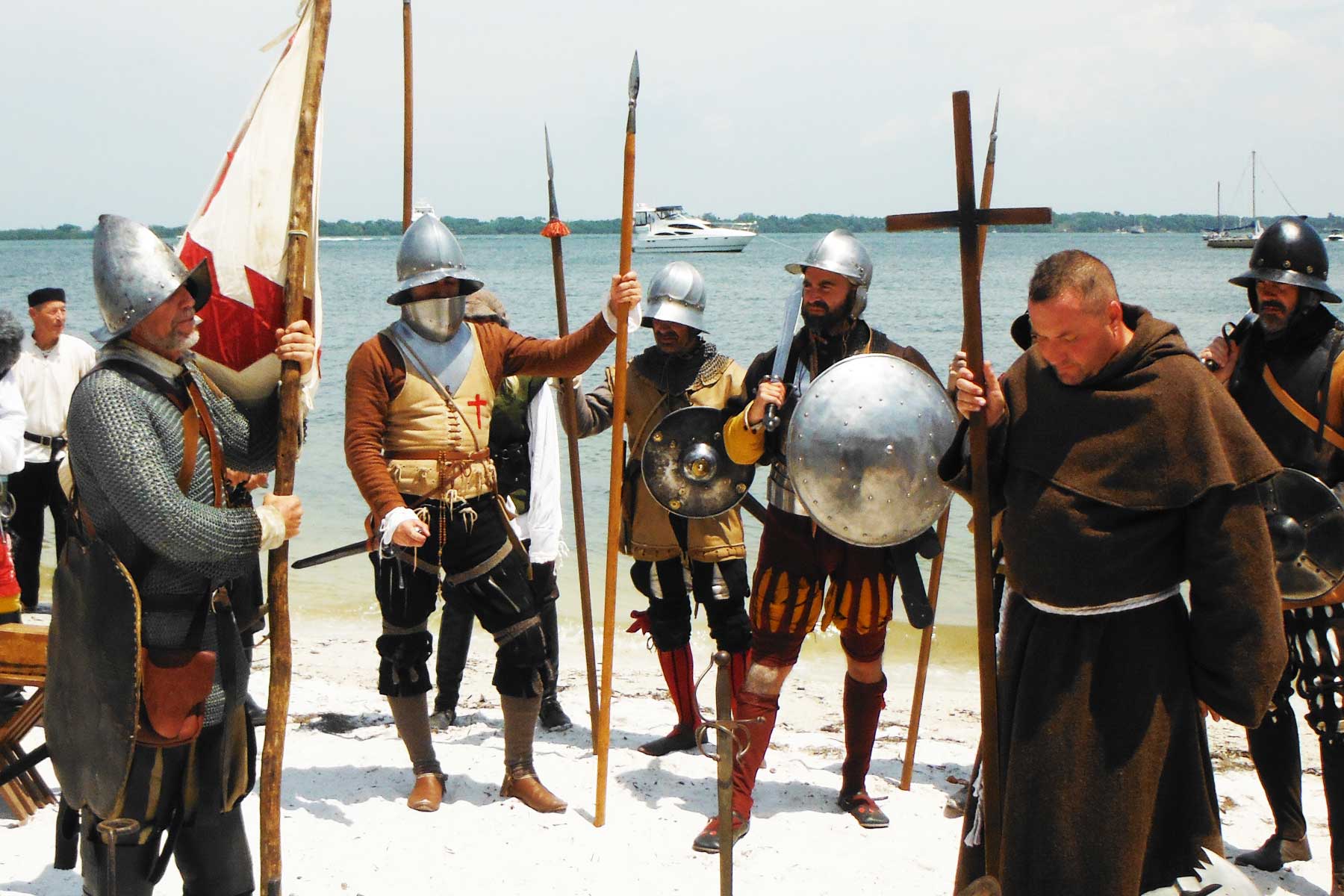
An Expedition Fraught With Challenges
The expedition was fraught with challenges, including conflicts with native tribes, harsh weather conditions, and a lack of resources. Many members of the expedition died during the journey, including de Soto himself, who died in 1542 in present-day Arkansas.
The memorial was established in 1948 to commemorate the expedition and its impact on the region. It features a visitor center with exhibits and a museum, as well as a nature trail that takes visitors through the local ecosystems, and ranger-led programs that provide visitors with an understanding of the history and significance of the expedition.
The memorial also offers a glimpse of the native cultures, and the impact of the first European contact on the native peoples.
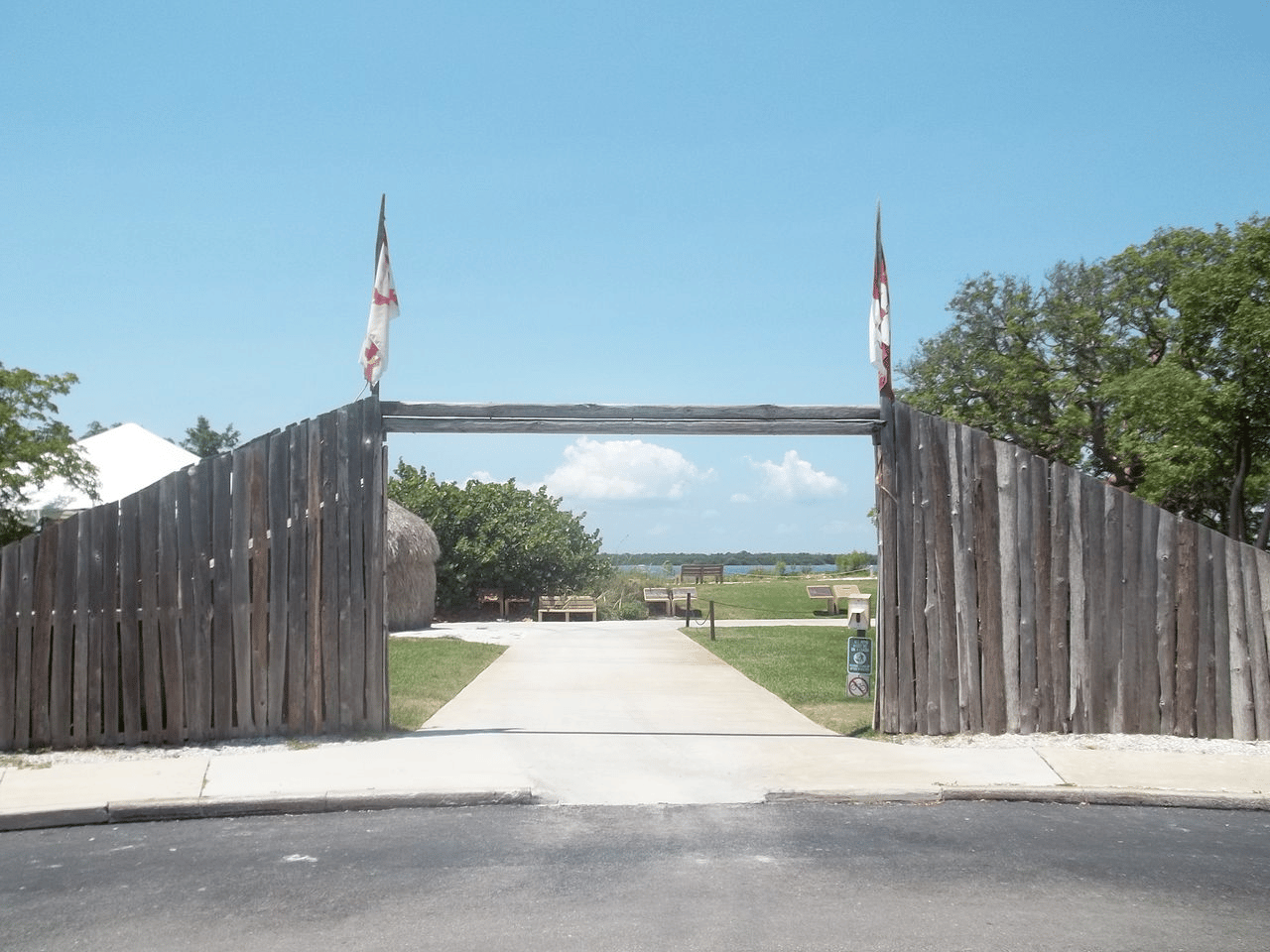
Top 15 Florida Landmarks
15. Gulf Islands National Seashore
We’re on to our Top 15 Florida landmarks. Our next landmark offers recreation opportunities and preserves natural and historic resources along the Gulf of Mexico barrier islands of Florida and Mississippi. At #15 on our list is Gulf Islands National Seashore.
The Gulf Islands National Seashore is a protected area that includes a series of barrier islands located along the Gulf of Mexico in the states of Florida and Mississippi. The seashore covers a total area of 137,000 acres and includes 12 separate units, including islands, beaches, and historic sites.
The Gulf Islands National Seashore was established in 1971 to preserve the natural beauty and cultural history of the Gulf Coast region. The area is home to a diverse range of ecosystems, including white sand beaches, salt marshes, and maritime forests.
These habitats support a wide variety of wildlife, including shorebirds, sea turtles, dolphins, and a variety of fish and invertebrates.

Fort Pickens Area – Gulf Islands National Seashore | Courtesy of Wikimedia Commons
It Features Pristine White Sand Beaches
One of the most popular attractions at the Gulf Islands National Seashore is the pristine white sand beaches, which stretch for miles along the Gulf of Mexico. Visitors can enjoy swimming, sunbathing, and a variety of water sports, including kayaking, paddleboarding, and snorkeling.
The Gulf Islands National Seashore also includes several historic sites, including the Fort Pickens Area in Florida and the Davis Bayou Area in Mississippi. These sites offer visitors the opportunity to learn about the area’s rich cultural history, including the impact of European settlement, the Civil War, and the fishing and maritime industries.
In addition to its natural and cultural attractions, the Gulf Islands National Seashore offers a wide range of recreational opportunities, including hiking, camping, fishing, and birdwatching.
The seashore is also home to several visitor centers, which provide information and educational programs about the area’s natural and cultural resources.
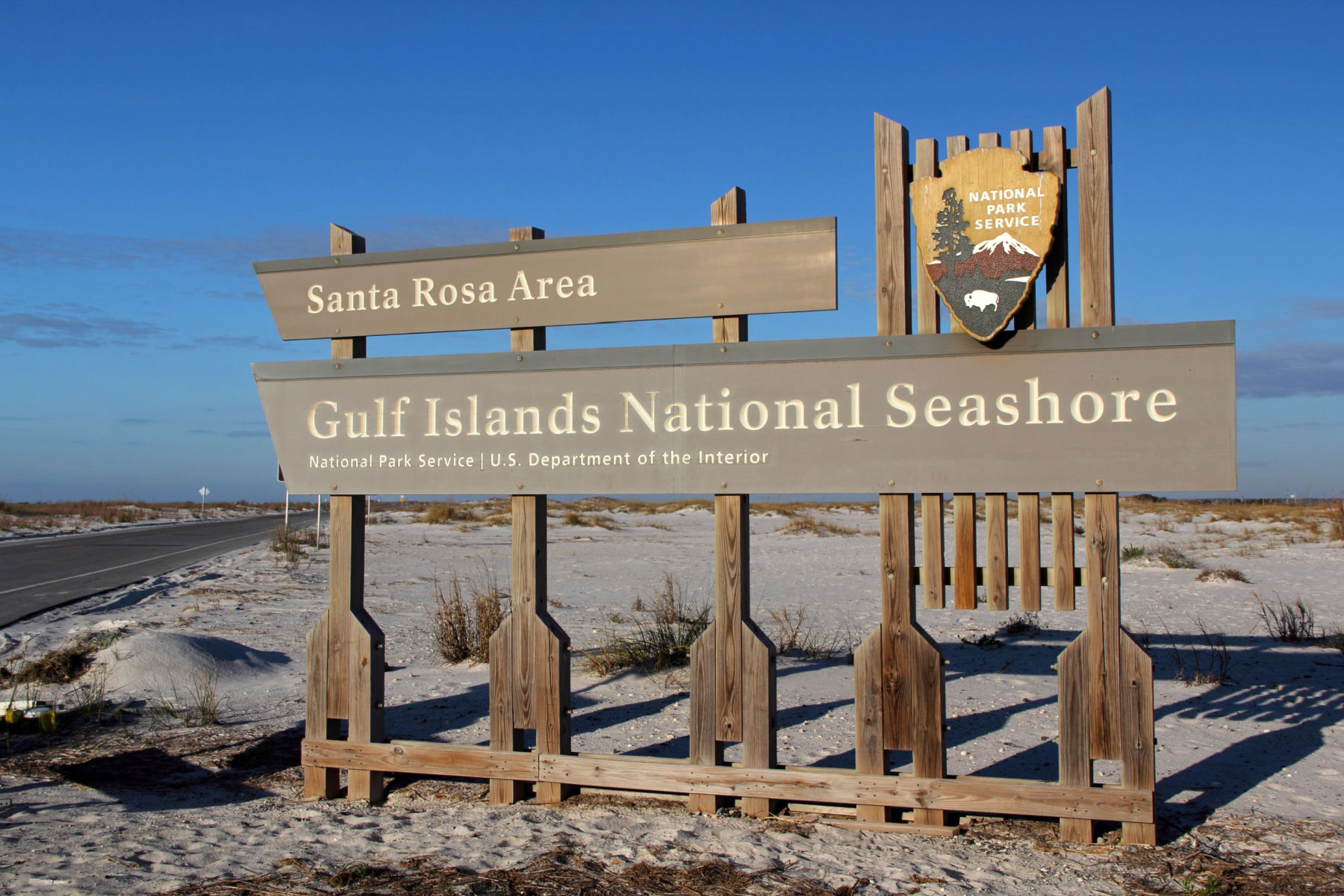
14. Castillo de San Marcos National Monument
Our next Florida landmark is the oldest masonry fort in the United States. Welcome to Castillo de San Marcos National Monument.
Historic Castillo de San Marcos National Monument, site of the oldest masonry fort in the United States, was built by the Spaniards on Matanzas Bay between 1672 and 1695 to protect the city of St. Augustine.
Established as Fort Marion National Monument in 1924, it was renamed in 1942.
Castillo de San Marcos National Monument preserves an incredible 17th century structure that is the oldest existing masonry fort in the continental U.S.
The fort itself has a dark history (especially under US control) having been used by the United States to imprison Native Americans including Chief Osceola and Geronimo.
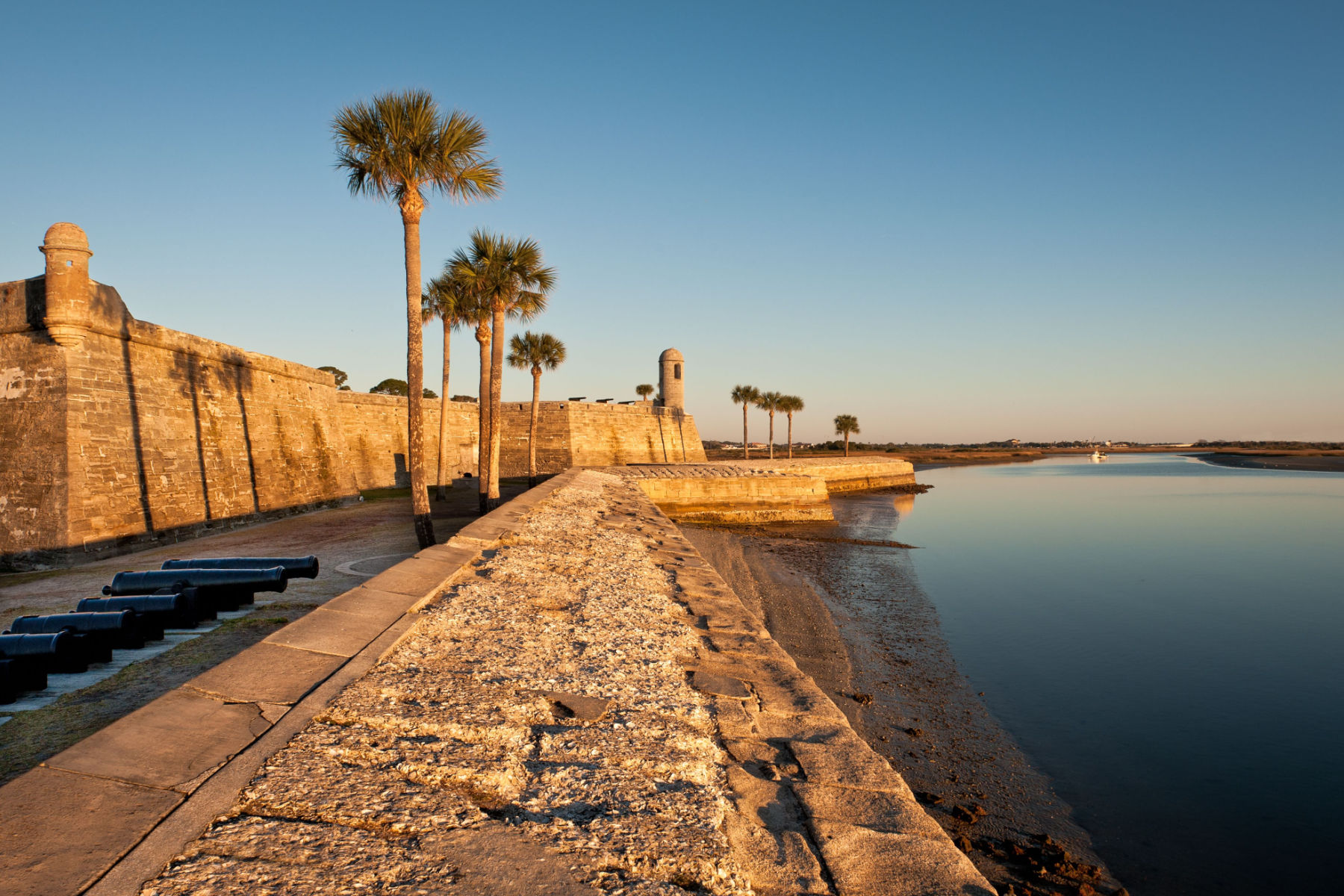
Things To Do & See
Rangers and volunteers are eager to answer your questions and provide interpretive opportunities throughout the day on the history and culture of the park. There are formal presentations where you can listen to a thematic program, usually 15-20 minutes long.
There are ongoing informal stations where you can engage firsthand with cultural objects, ask your burning questions, and spend as little or as much time as you would like.
Program topics, locations, and times vary on the season, weather, and visitation. Please ask the staff upon arrival or look for a sign in the courtyard area for the upcoming opportunities.
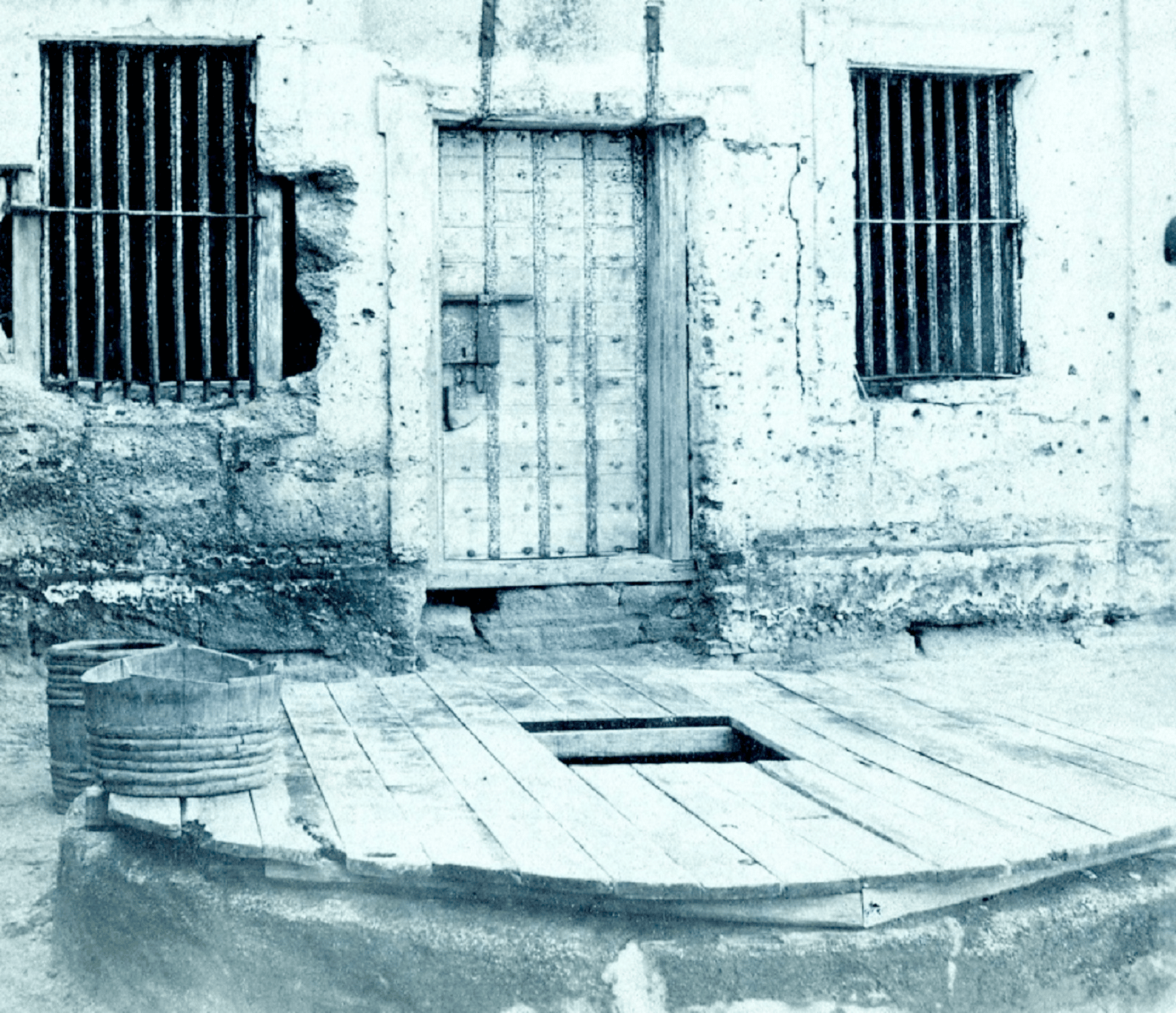
13. Ponce de Leon Inlet Lighthouse & Museum
Our next Florida landmark is Florida’s tallest lighthouse It’s also a traveler favorite, thanks to the well-preserved structures and rich history. At #13 on our list of the Best Florida Landmarks is the Ponce de Leon Inlet Lighthouse & Museum.
The Ponce de Leon Inlet Lighthouse & Museum was built in 1887 and stands at 175 feet tall, making it the tallest lighthouse in Florida and one of the tallest lighthouses in the country. The lighthouse is open to the public as a museum, offering visitors the opportunity to learn about its history and explore its interior.
The Ponce de Leon Inlet Lighthouse was built to guide ships through the treacherous waters of the Florida coast, which were known for their many reefs and sandbars. The lighthouse is made of brick and is topped with a black and white spiral-striped beacon. It was automated in 1970 and is still in operation today, although the light is no longer used for navigation.

See A Variety Of Exhibits & Artifacts
The museum at the Ponce de Leon Inlet Lighthouse offers a variety of exhibits and artifacts related to the lighthouse’s history and the history of the local area. Visitors can climb the 203 steps to the top of the lighthouse for panoramic views of the surrounding area, including the Atlantic Ocean and the Halifax River.
The museum also features exhibits on the lives of the lighthouse keepers who worked at the Ponce de Leon Inlet Lighthouse over the years. Visitors can learn about the challenges of maintaining the lighthouse and the daily routines of the keepers and their families.
In addition to its historical and cultural significance, the Ponce de Leon Inlet Lighthouse is also an important landmark for wildlife conservation. The surrounding area is home to a variety of endangered and threatened species, including sea turtles, manatees, and many species of birds. The museum works closely with local conservation organizations to protect these species and their habitats.
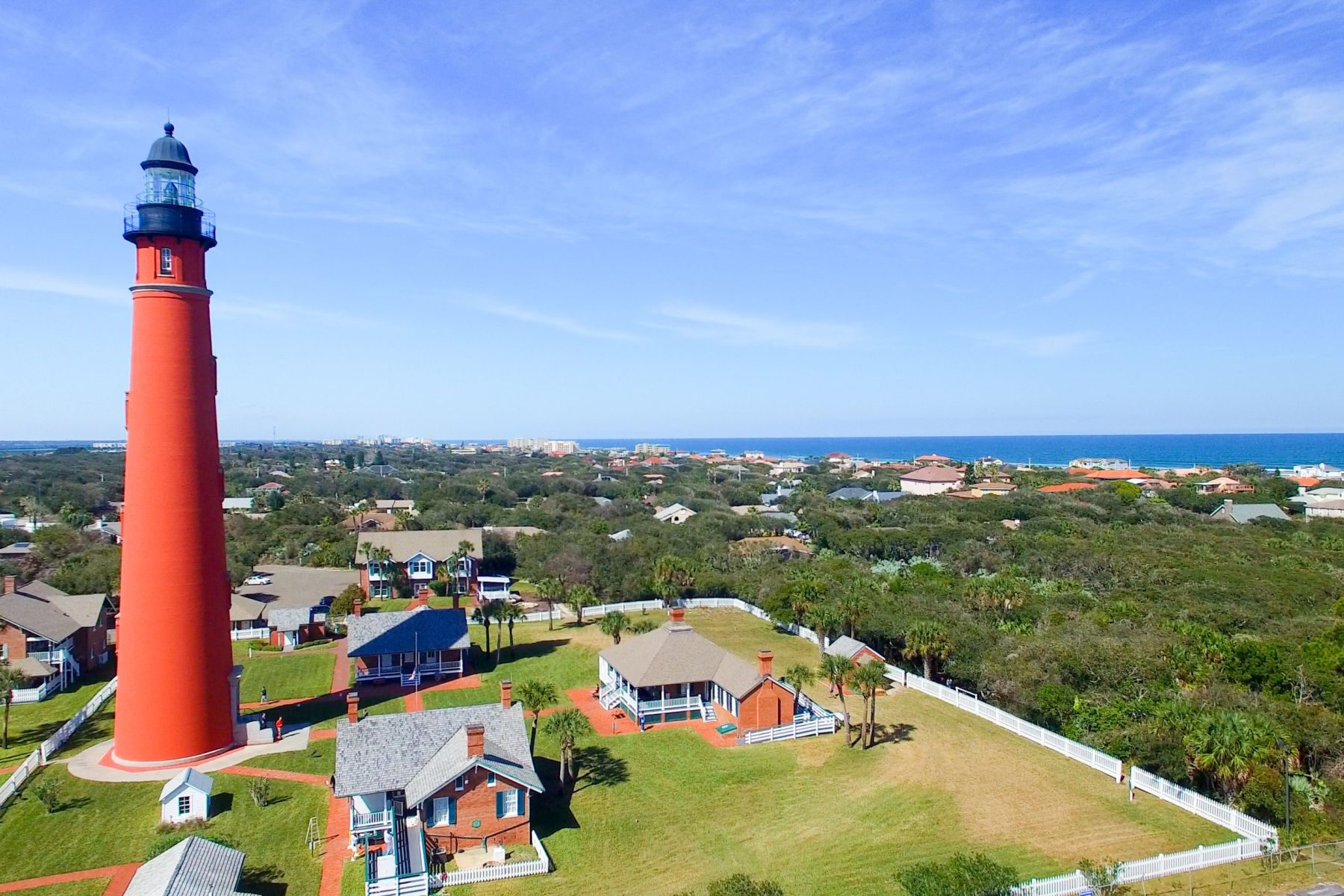
12. Art Deco Historic District
Our next Florida landmark boasts colorful buildings, interesting décor elements, intricate details and a century-old history that offers a glimpse into a bygone era. At #12 on our list of the Best Florida Landmarks is the Art Deco Historic District.
The Art Deco Historic District is a neighborhood in Miami Beach, Florida that is famous for its unique architecture and cultural significance. The district covers an area of approximately one square mile and includes more than 800 historic buildings, many of which were constructed during the 1920s and 1930s.
The Art Deco movement, which originated in France in the 1920s, was characterized by its use of geometric shapes, bold colors, and decorative patterns. This style quickly spread to the United States and became popular in Miami Beach during the 1930s, as the city experienced a period of rapid growth and development.
Many of the buildings in the Art Deco Historic District were designed by prominent architects of the time, including: Henry Hohauser, L. Murray Dixon, and Albert Anis. The buildings feature distinctive Art Deco details such as rounded corners, flat roofs, and pastel-colored facades. They are also adorned with decorative elements such as terrazzo floors, glass blocks, and neon lights.
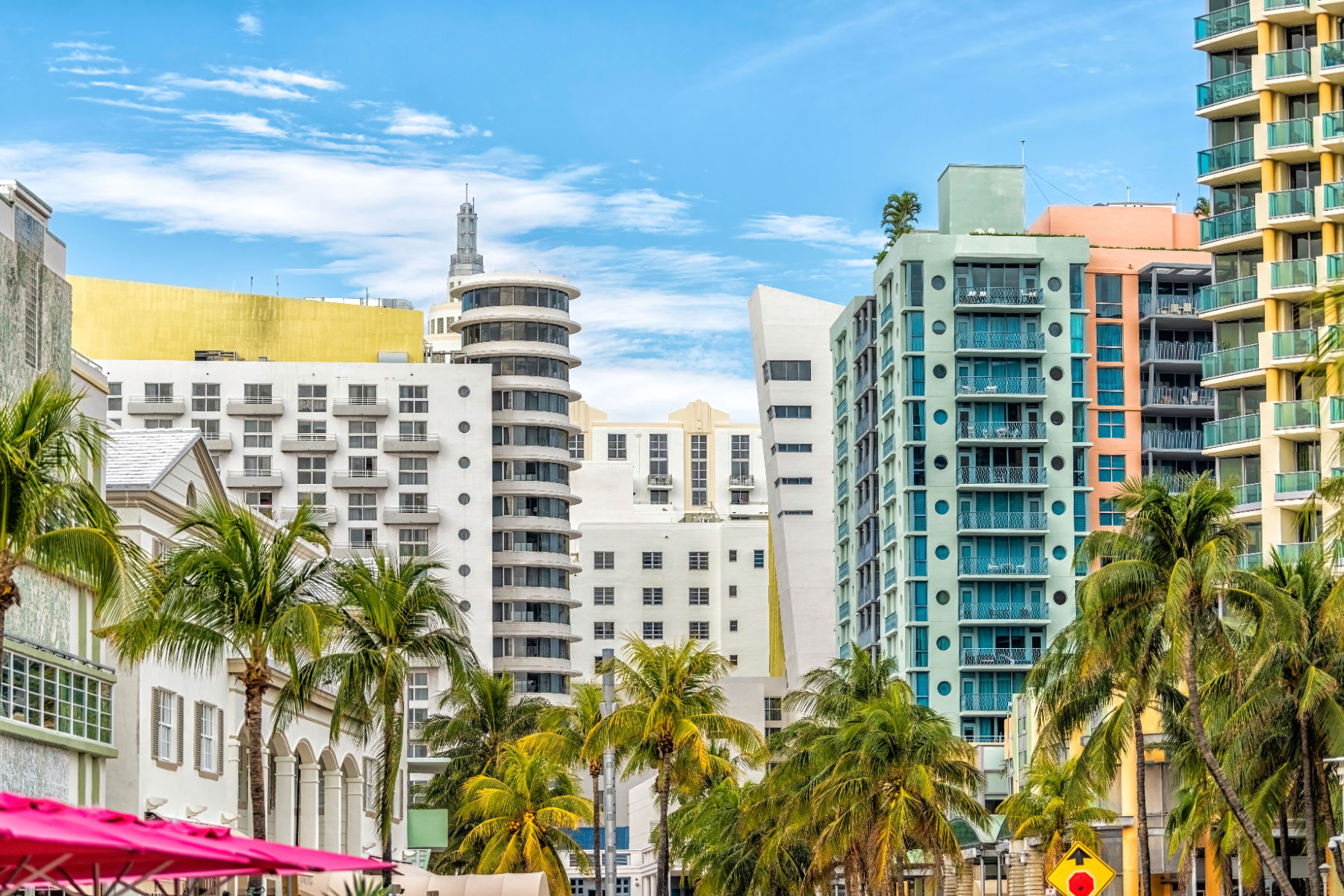
The Art Deco Historic District Played An Important Role In The Social & Cultural History Of Miami Beach
In addition to their architectural significance, the buildings in the Art Deco Historic District played an important role in the social and cultural history of Miami Beach. During the 1930s and 1940s, the district was a popular destination for tourists and celebrities, who were drawn to its vibrant nightlife and glamorous atmosphere.
The district’s many hotels and restaurants were frequented by celebrities such as Frank Sinatra, Elizabeth Taylor, and Jackie Gleason.
Despite its popularity during the mid-20th century, the Art Deco Historic District fell into disrepair during the 1960s and 1970s as many of the buildings were neglected and left to decay. In the 1980s, a group of preservationists and community activists formed the Miami Design Preservation League to save the district from demolition and restore it to its former glory.
Thanks to their efforts, the Art Deco Historic District was added to the National Register of Historic Places in 1979 and has since become one of Miami Beach’s most popular tourist attractions.
Today, visitors to the Art Deco Historic District can take walking tours of the neighborhood, visit museums and galleries dedicated to Art Deco design, and attend events such as the annual Miami Beach Art Deco Weekend. The district’s many shops, restaurants, and nightclubs also offer visitors a taste of Miami Beach’s unique culture and vibrant nightlife.
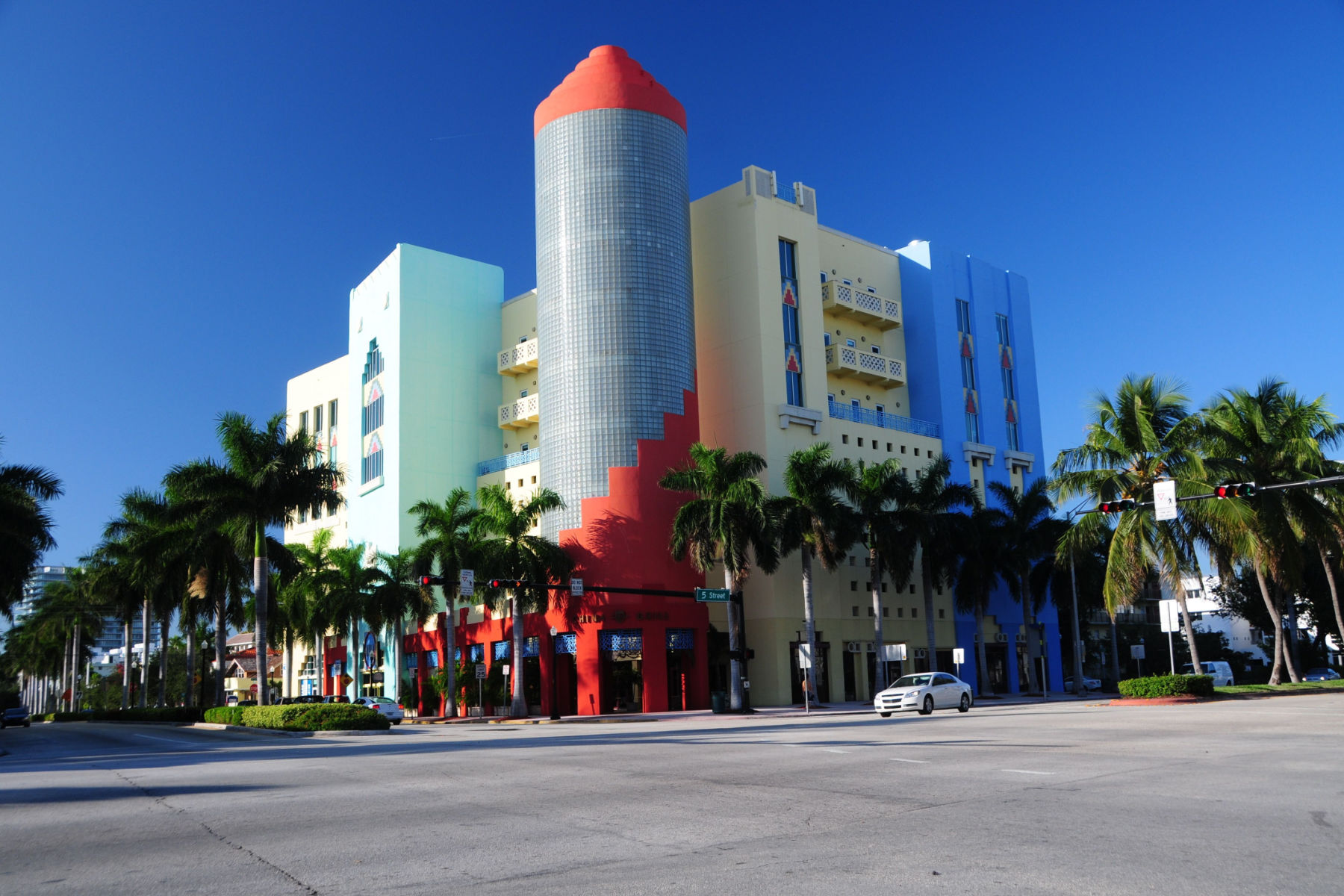
11. Fort Matanzas National Monument
Another amazing Florida landmark is Fort Matanzas National Monument. It’s #11 on our list of the Best Florida Landmarks.
Fort Matanzas is located on the southern tip of Anastasia Island. It commemorates the Spanish fort of San Marcos de Matanzas, which was built by the Spanish in 1740-1742 to protect the southern approach to the city of St. Augustine from potential British and French invasion.
The fort was named after the Matanzas River, which runs nearby, and was strategically located on the Matanzas Inlet, which provided access to the Matanzas River and St. Augustine. The fort was manned by a small detachment of soldiers and was equipped with cannons.
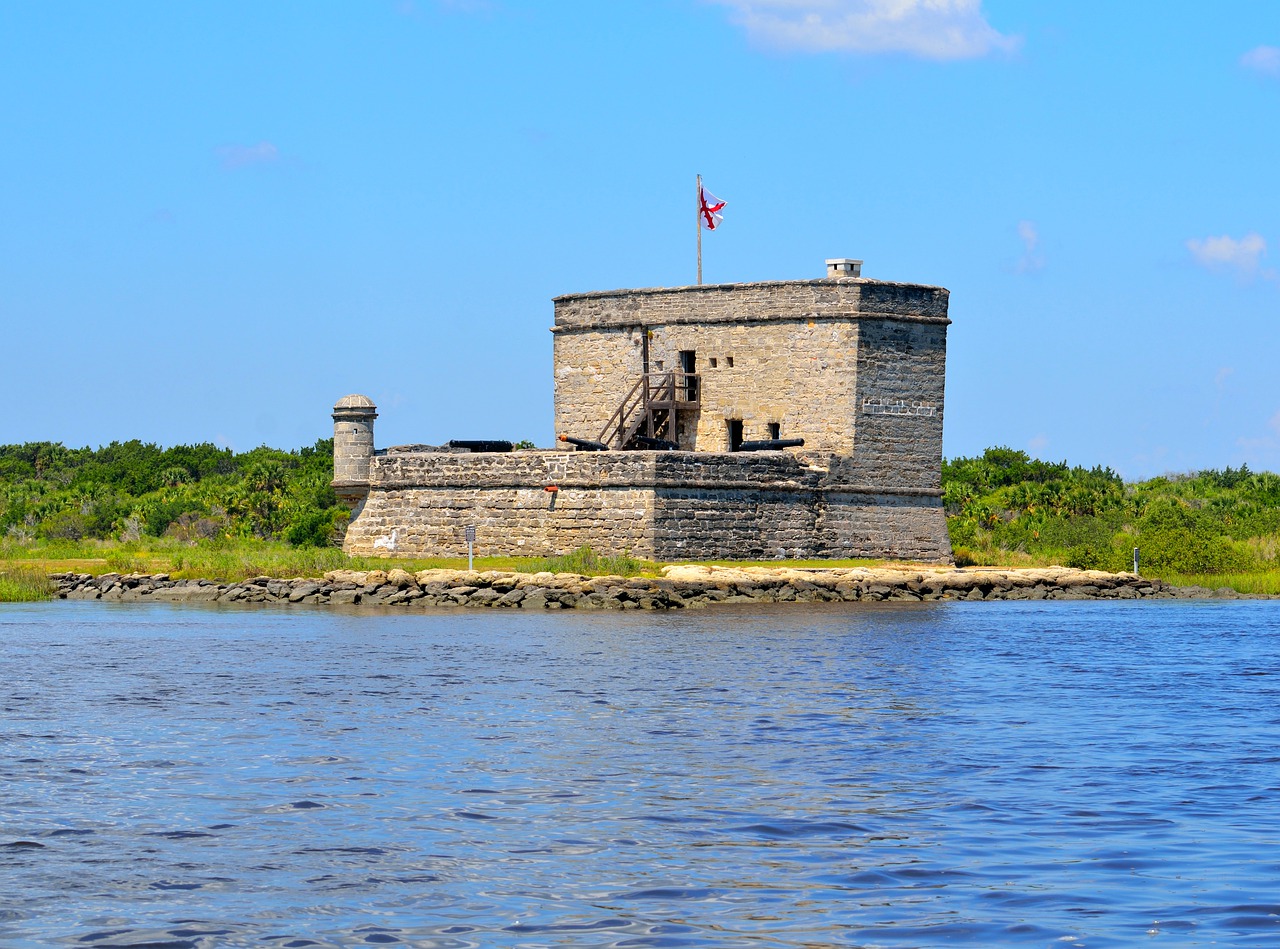
It Repelled A British Attack
In 1742, the fort successfully repelled an attack by a British naval force under the command of Governor James Oglethorpe of the British colony of Georgia.
The fort remained active during the 18th century and played a role in the defense of St. Augustine during the American Revolutionary War.
The fort was later abandoned by the Spanish in the late 18th century and fell into disrepair. It was rediscovered by the National Park Service in the early 20th century and was designated as a National Monument in 1924.
Today, the monument is open to the public and offers visitors the opportunity to tour the reconstructed fort, which has been restored to its 18th-century appearance, and learn about the history and significance of the fort.
Top 10 Florida Landmarks
10. Nike Missile Base in Everglades National Park
We’re on to our Top 10 Florida landmarks. We move from an 18th century fort to a more recent military installation which is a remnant of the Cold War era. At #10 on our list of the Best Historic Sites In Florida is the Nike Missile Base in Everglades National Park.
The base was part of a nationwide network of missile bases established by the United States Army during the 1950s and 1960s to defend against potential air attacks by the Soviet Union.
The Nike missile base in Everglades National Park was built in the early 1960s and was operational until the late 1970s.
It consisted of a missile launch site and a control center, both of which were underground. The base was equipped with Nike Ajax missiles, which were short-range, surface-to-air missiles designed to intercept and destroy incoming aircraft.
During its operational period, the base was manned by a small detachment of soldiers, who were responsible for the maintenance and operation of the missiles. The base was also equipped with radar and other electronic systems that were used to detect and track incoming aircraft.
After the missile base was decommissioned in the late 1970s, the land was returned to the National Park Service, which now operates the site as a historical monument. The base has been preserved in its original condition and is open to the public for tours.
Visitors can explore the underground missile launch site and control center, and learn about the history of the Cold War and the role of the Nike missile program in the defense of the United States.
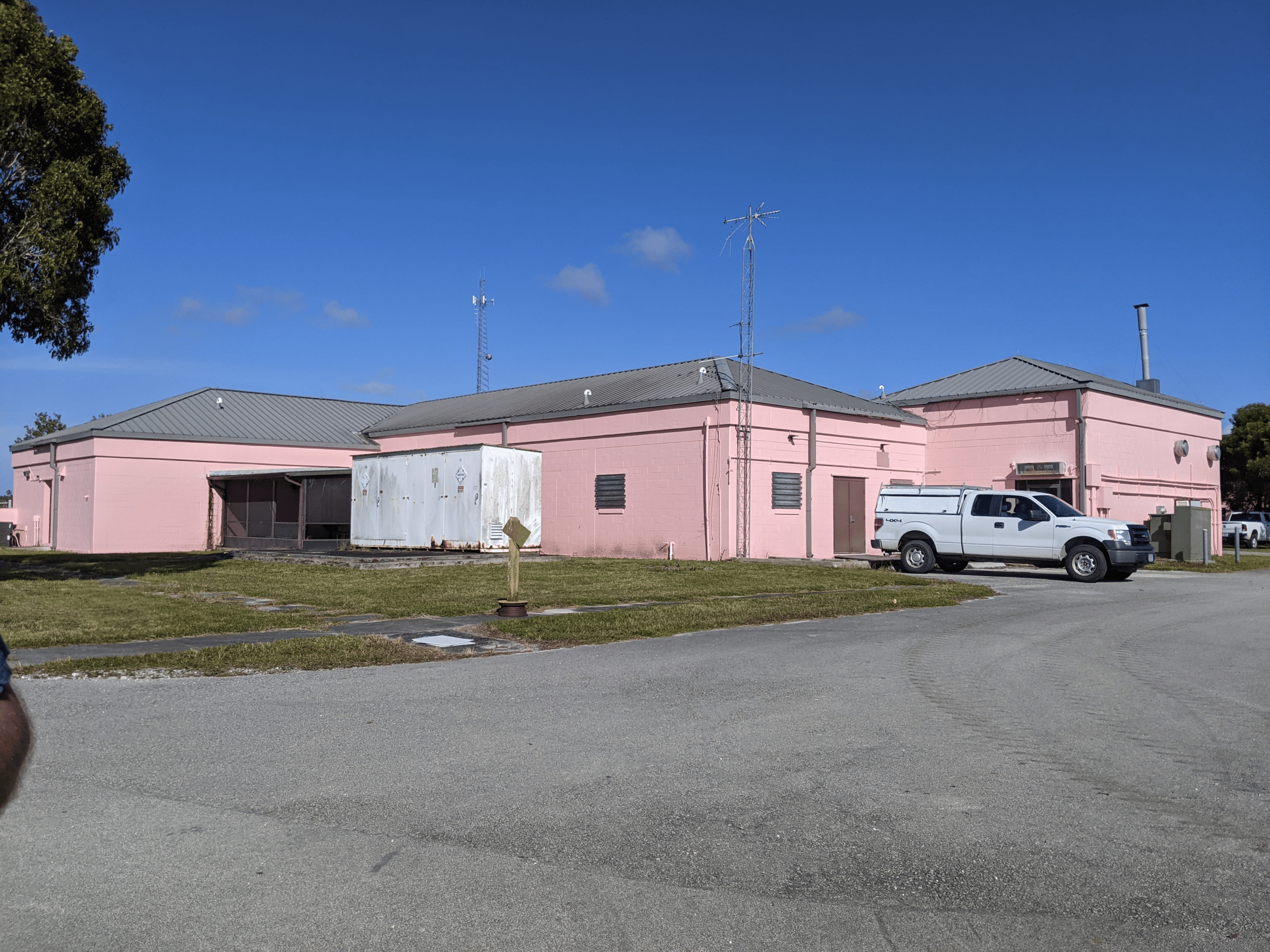
9. Timucuan Ecological & Historic Preserve
Our next Florida landmark offers years of history and the natural beauty of salt marshes and coastal dunes. The history and culture of this place stretches over 6,000 years. Hear the life stories of the native people who survived in Florida’s environment prior to European contact.
At #9 on our list of the Best Florida Landmarks is the Timucuan Ecological & Historic Preserve.
The history of the preserve dates back to the pre-Columbian era, when the Timucuan people, a Native American tribe, inhabited the area. The Timucuan people were skilled farmers and fishermen who built villages along the riverbanks and coast. They also created a complex social and political structure, with chiefs ruling over multiple villages.
In the 16th century, the Spanish arrived in Florida and established settlements in the region. The Timucuan people were subjected to disease and forced labor, and many were killed or displaced. The Spanish eventually abandoned the area, and it remained largely uninhabited until the late 19th century.

Timucuan Salt Marsh | Courtesy of Wikimedia Commons
The Region Attracted Wealthy Visitors
In the 1800s, the region began to attract wealthy visitors who came to hunt, fish, and explore the natural beauty of the area. In the early 20th century, a developer named George Hardee began buying up land in the area and promoting it as a tourist destination. He built a resort and several homes, but the area remained relatively undeveloped until after World War II.
In the post-war years, the area began to experience rapid growth and development, with new homes, roads, and businesses sprouting up throughout the region. Concerned citizens and conservationists worked to preserve the remaining natural areas, and in 1988 the Timucuan Ecological and Historic Preserve was established.
Today, the preserve encompasses over 46,000 acres of protected land, including wetlands, forests, and historic sites. Visitors can explore the area through hiking trails, guided tours, and educational programs, and learn about the natural and cultural history of the region.
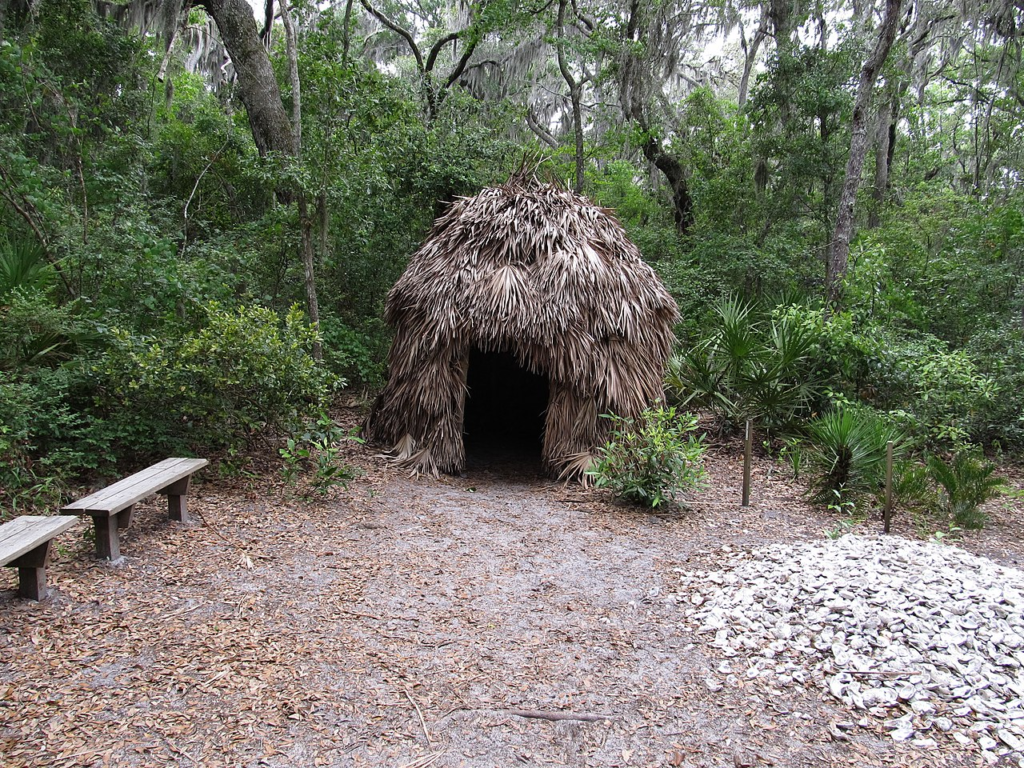
8. Tampa Zoo
Our next Florida landmark is known for its beautiful tropical wildlife setting, bringing animals and guests together to create unforgettable natural connections. At #8 on our list of the Best Florida Landmarks is the Tampa Zoo.
The Tampa Zoo, also known as the Lowry Park Zoo, is a popular wildlife conservation and education center located in Tampa, Florida. It was established in 1957 and has since become one of the most visited zoos in the state of Florida.
The zoo covers an area of 56 acres and is home to over 1,300 animals from more than 200 species, including many endangered species from around the world. The animals are kept in naturalistic habitats that mimic their natural environments, providing visitors with an immersive experience.
Some of the popular animal exhibits at the Tampa Zoo include: the Florida Manatee and Aquatic Center, the Primate World exhibit, the Asian Gardens, the Wallaroo Station Children’s Zoo, and the Safari Africa exhibit.
Apart from animal exhibits, the zoo offers a variety of educational programs, including interactive experiences, camps, and tours, to educate visitors on animal conservation and the importance of protecting wildlife.
The Tampa Zoo is a great place to visit for animal lovers of all ages, offering a fun and educational experience while promoting conservation and animal welfare.
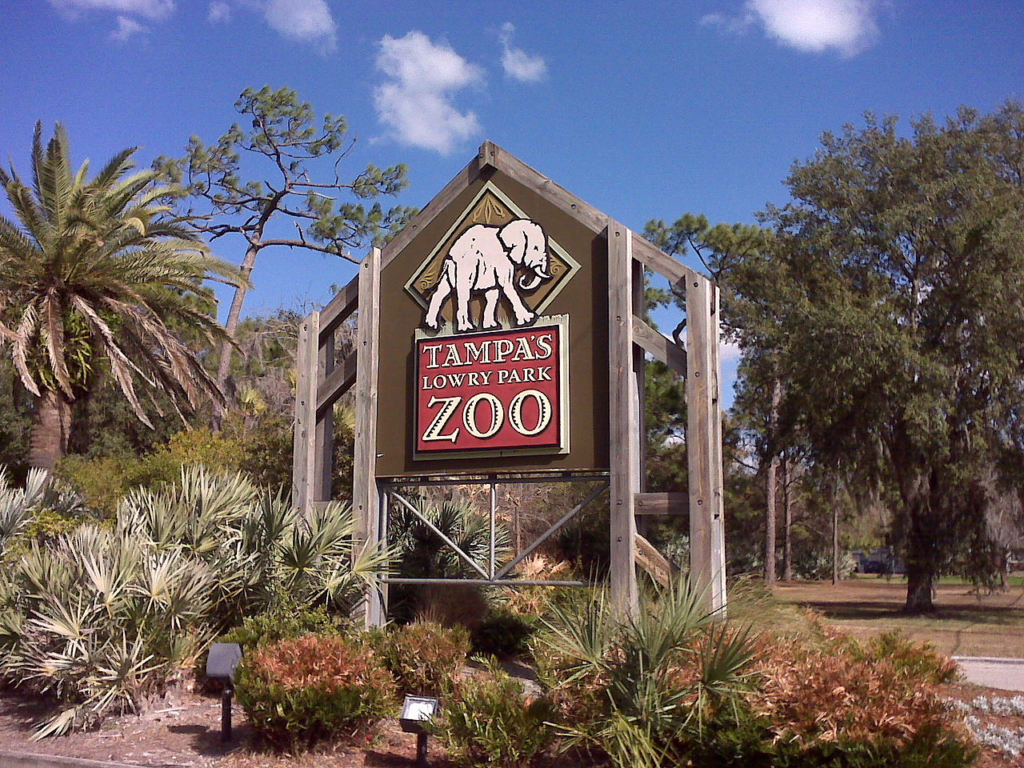
7. Dry Tortugas National Park
Our next Florida landmark is a 100-square mile park is mostly open water with seven small islands. Accessible only by boat or seaplane, the park is known the world over as the home of magnificent Fort Jefferson, picturesque blue waters, superlative coral reefs and marine life, and the vast assortment of bird life that frequents the area.
At #7 on our list of the Best Florida Landmarks is Dry Tortugas National Park.
The history of Dry Tortugas National Park can be traced back to the early 16th century when Spanish explorers first visited the area. The islands were named “Dry Tortugas” by Spanish explorer Juan Ponce de León because of the large number of sea turtles he saw in the area, and the lack of fresh water on the islands.
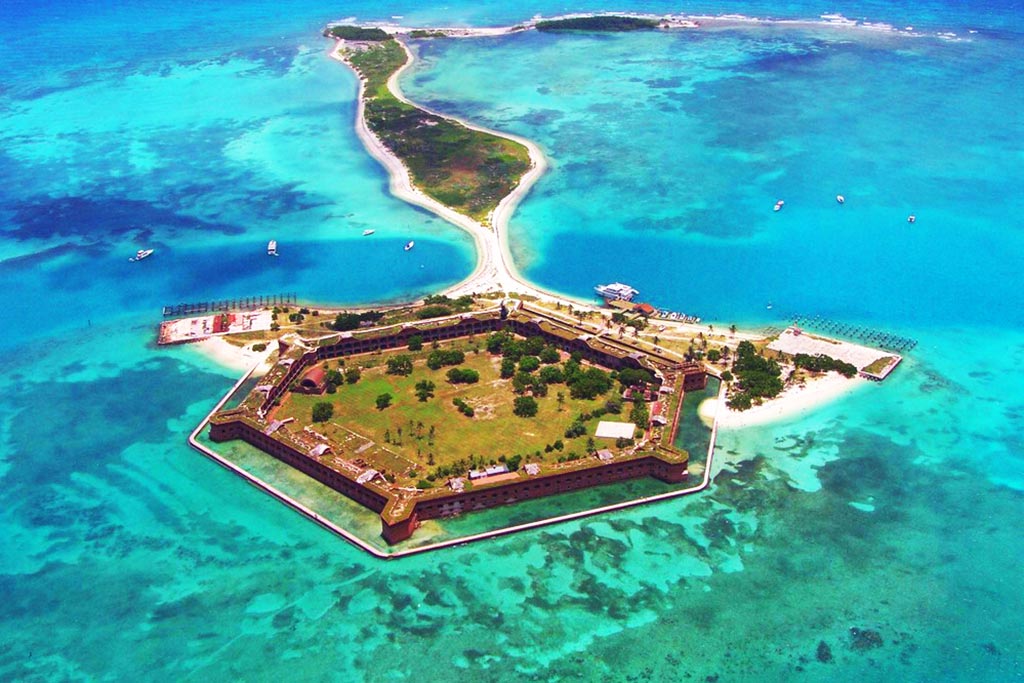
The U.S. Build Fort Jefferson
In 1822, the United States claimed the islands and began construction of Fort Jefferson, a massive coastal fortress designed to protect the Gulf of Mexico and serve as a base for naval operations in the region. Construction of the fort took over 30 years to complete and was never fully finished.
In 1935, Dry Tortugas was designated a national monument by President Franklin D. Roosevelt, and in 1992, it was upgraded to a national park, becoming one of the most remote and least visited national parks in the United States.
Today, Dry Tortugas National Park is a popular destination for visitors who enjoy snorkeling, diving, birdwatching, and exploring the history of the area. Visitors can tour Fort Jefferson, camp on the islands, and enjoy the natural beauty and wildlife of the park.
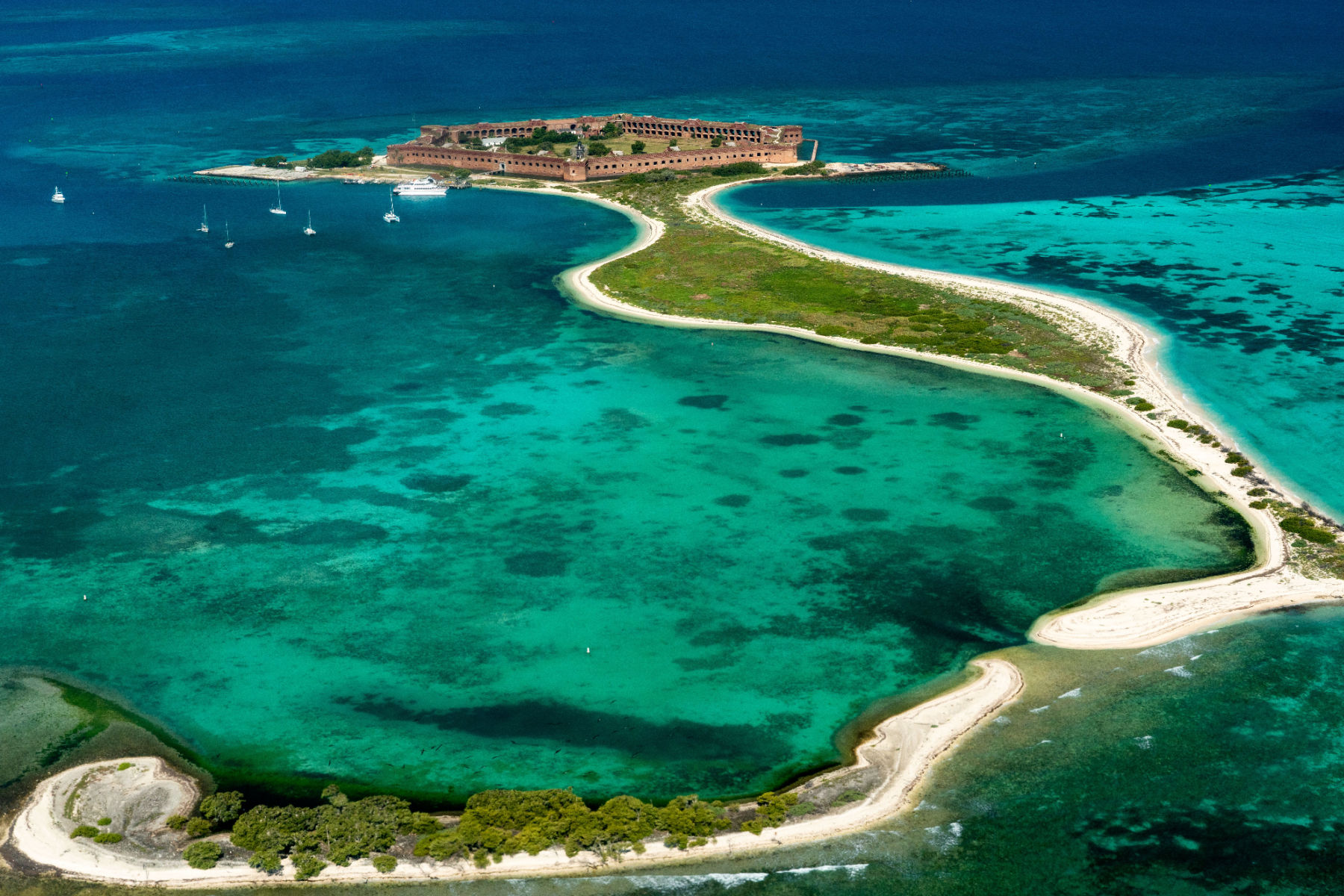
Things To Do
Here are some of the top things to do:
- Explore Fort Jefferson: The main attraction of the park is Fort Jefferson, a massive coastal fortress that was built in the 19th century. Visitors can take a guided tour of the fort and learn about its history and significance.
- Snorkel or dive: The crystal-clear waters surrounding the islands are perfect for snorkeling and diving. Visitors can see colorful coral reefs, tropical fish, sea turtles, and shipwrecks.
- Camp on the islands: Camping on the islands is an unforgettable experience, offering a chance to sleep under the stars and wake up to the sound of the waves.
- Birdwatching: Dry Tortugas is home to a variety of migratory birds, including sooty terns, brown noddies, and frigatebirds. Visitors can watch them from the shore or take a boat tour to see them up close.
- Kayaking and paddleboarding: Visitors can rent kayaks and paddleboards to explore the calm waters around the islands.
- Fishing: Fishing is allowed in some areas of the park, and visitors can catch a variety of fish, including tarpon, snapper, and grouper.
- Relax on the beach: The beaches on the islands are pristine and uncrowded, offering a peaceful place to relax and soak up the sun.
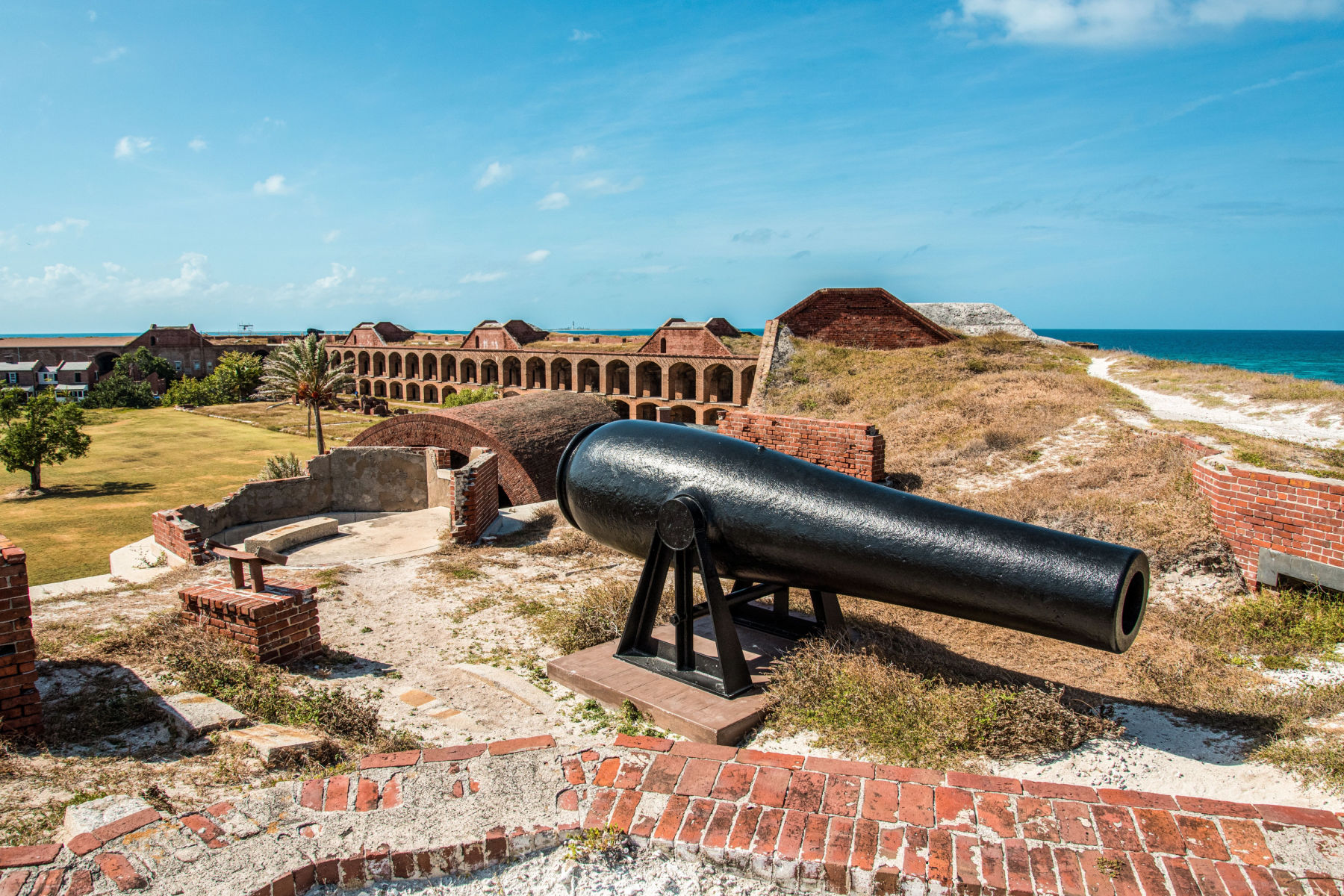
6. Fernandina Beach on Amelia Island
Our next Florida landmark is a 50-block area at the north end of Amelia Island and is recognized by the National Register of Historic Places. This area was once a Victorian seaport village – home to pirates, Gilded Age millionaires, bootleggers, shrimpers, and other characters.
At #6 on our list of the Best Florida Landmarks is Fernandina Beach on Amelia Island.
Fernandina Beach is known for its rich history, stunning beaches, and a quaint, small-town feel that makes it a popular vacation destination.
One of the most notable features of Fernandina Beach is its historic district, which is listed on the National Register of Historic Places. The district features a collection of beautifully preserved buildings, many of which date back to the 19th century. Visitors can take a leisurely stroll through the district’s charming streets and admire the architecture, or explore the many shops, art galleries, and restaurants that line the area.
Of course, no trip to Fernandina Beach is complete without a visit to the beach itself. Amelia Island boasts some of the most beautiful and pristine beaches in the country, with soft, white sand and crystal-clear waters. Visitors can swim, sunbathe, or take part in a variety of water activities like surfing, paddleboarding, or kayaking.
In addition to its natural beauty and historic charm, Fernandina Beach is also home to several cultural attractions, including museums, art galleries, and performing arts centers. The town hosts a variety of festivals and events throughout the year, celebrating everything from music and food to art and history.
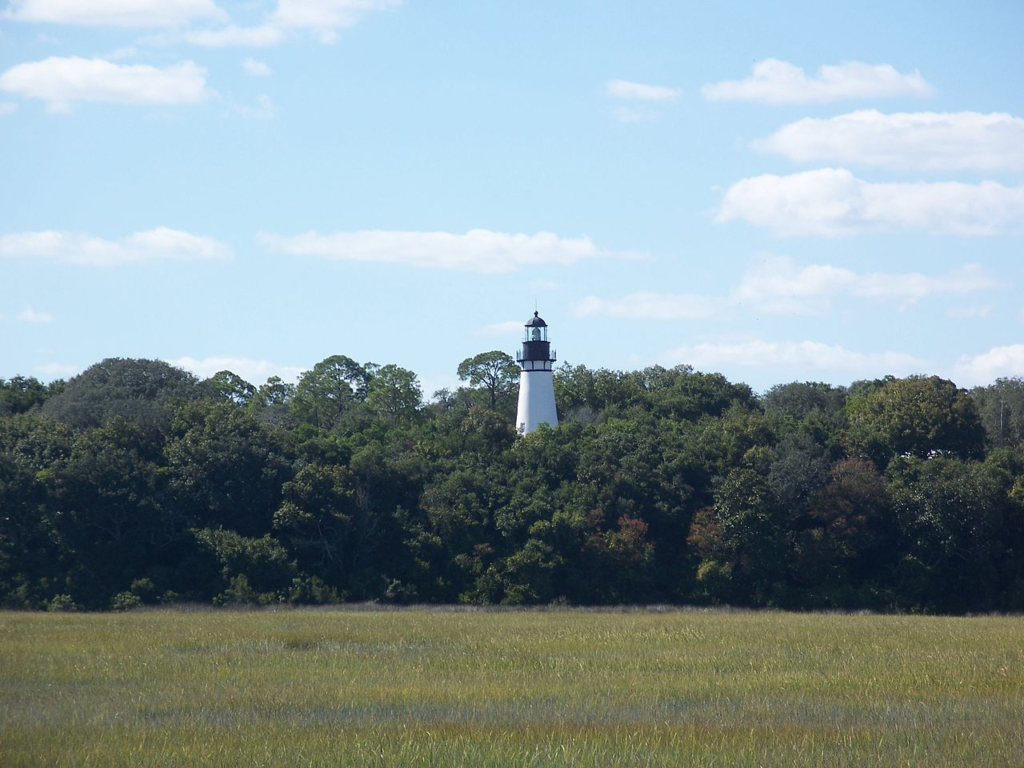
Top 5 Florida Landmarks
5. Miami Beach
We’re on to our Top 5 Florida landmarks. At #5 is a place that offers a variety that goes far beyond sun and sand, encompassing world-famous nightlife and world-renowned art galleries, first-class hotels and second-to-none dining, designer shopping and a unique architectural style that makes it one of the world’s most visually distinctive regions.
Welcome to Miami Beach.
Miami Beach has a rich and fascinating history, with roots that date back to the late 1800s. In the early days, Miami Beach was little more than a strip of land with a few scattered buildings and homes. However, the area began to grow and flourish in the early 20th century, thanks in large part to the efforts of a handful of visionary developers and investors.
One of the most important figures in the early development of Miami Beach was Carl Fisher, a businessman and entrepreneur who saw the potential for the area to become a premier destination for tourists and vacationers. Fisher worked tirelessly to promote and market Miami Beach, building hotels, restaurants, and other attractions that would appeal to visitors.
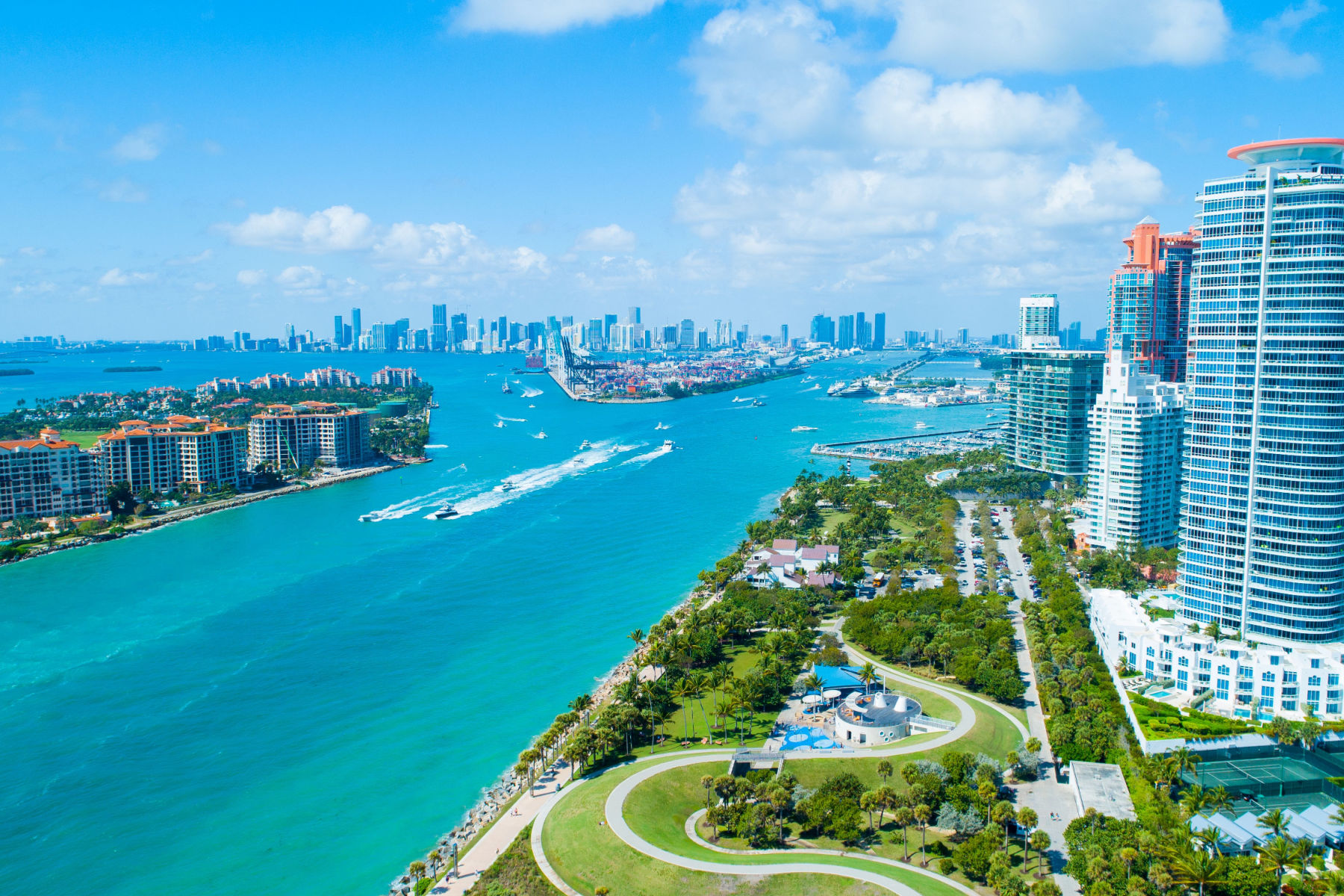
Miami Beach Experienced A Building Boom
In the 1920s, Miami Beach experienced a building boom, with a flurry of new construction and development taking place. Many of the iconic Art Deco buildings that still stand today were built during this time, including the famous Colony Hotel and the McAlpin Hotel.
During World War II, Miami Beach played an important role in the war effort, serving as a training center for thousands of soldiers and sailors. After the war, the area continued to grow and evolve, with new hotels, restaurants, and nightclubs springing up to cater to a new generation of tourists and vacationers.
In the 1960s, Miami Beach became a hub for the civil rights movement, with African American activists and leaders fighting to desegregate the area’s beaches and hotels. The struggle for civil rights in Miami Beach was an important chapter in the larger struggle for equality and justice in the United States.
Today, Miami Beach remains a vibrant and exciting destination for tourists from around the world, with a rich history and culture that continues to attract visitors and residents alike.

4. Fort Jefferson in the Dry Tortugas
Our next Florida landmark was originally built to protect one of the most strategic deepwater anchorages in North America. By fortifying this spacious harbor, the United States maintained an important “advance post” for ships patrolling the Gulf of Mexico and the Straits of Florida.
At #4 on our list of the Best Florida Landmarks is Fort Jefferson in the Dry Tortugas.
Fort Jefferson is a massive coastal fortress located on Garden Key in the Dry Tortugas, a group of islands off the coast of Florida. The fort has a rich and fascinating history that spans over a century.
Construction on Fort Jefferson began in 1846, shortly after the United States acquired Florida from Spain. The fort was built to protect the shipping lanes that ran between the Gulf of Mexico and the Atlantic Ocean, and to serve as a base for the US Navy in the region.
The construction of the fort was a massive undertaking, requiring over 16 million bricks and taking over 30 years to complete. The fort was designed to be a self-sufficient military outpost, with its own water supply, barracks, and even a prison.
During the Civil War, Fort Jefferson played a key role in the Union’s efforts to blockade the Confederate ports in the Gulf of Mexico. The fort was home to a garrison of Union soldiers, who worked tirelessly to maintain the blockade and prevent Confederate ships from running supplies into the South.
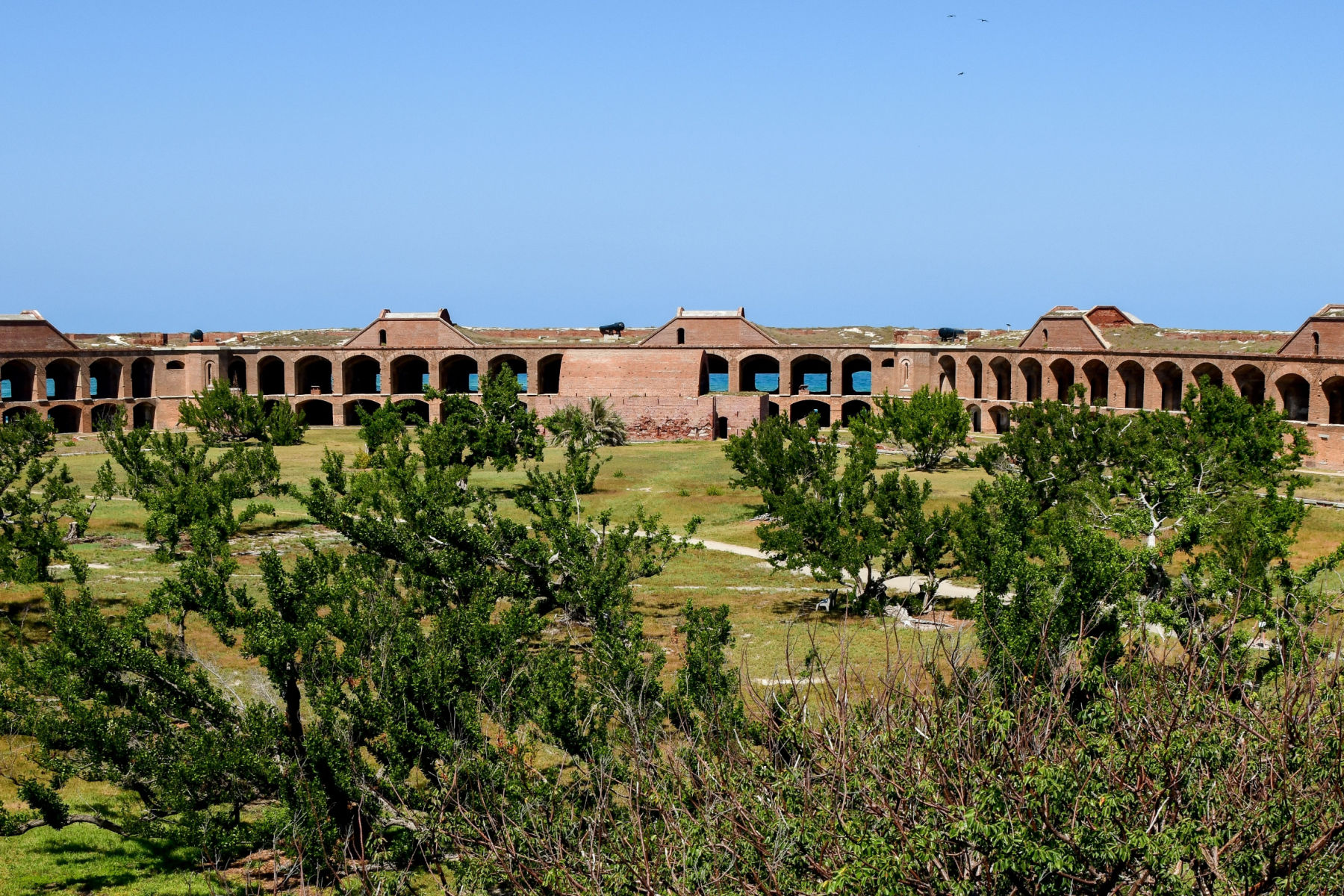
Fort Jefferson & The Lincoln Assassination
In addition to its military history, Fort Jefferson is also known for its connection to one of America’s most famous figures, Dr. Samuel Mudd. Mudd was a Maryland physician who was imprisoned at Fort Jefferson after being convicted of conspiracy in the assassination of President Abraham Lincoln. Mudd famously helped treat the broken leg of John Wilkes Booth, one of the conspirators in the assassination plot.
Today, Fort Jefferson is a popular tourist destination and a National Historic Site. Visitors can tour the fort and learn about its rich history, explore the surrounding islands and coral reefs, and take part in a variety of outdoor activities like snorkeling, kayaking, and birdwatching.
The fort remains an important reminder of America’s military history and its role in shaping the country’s future.
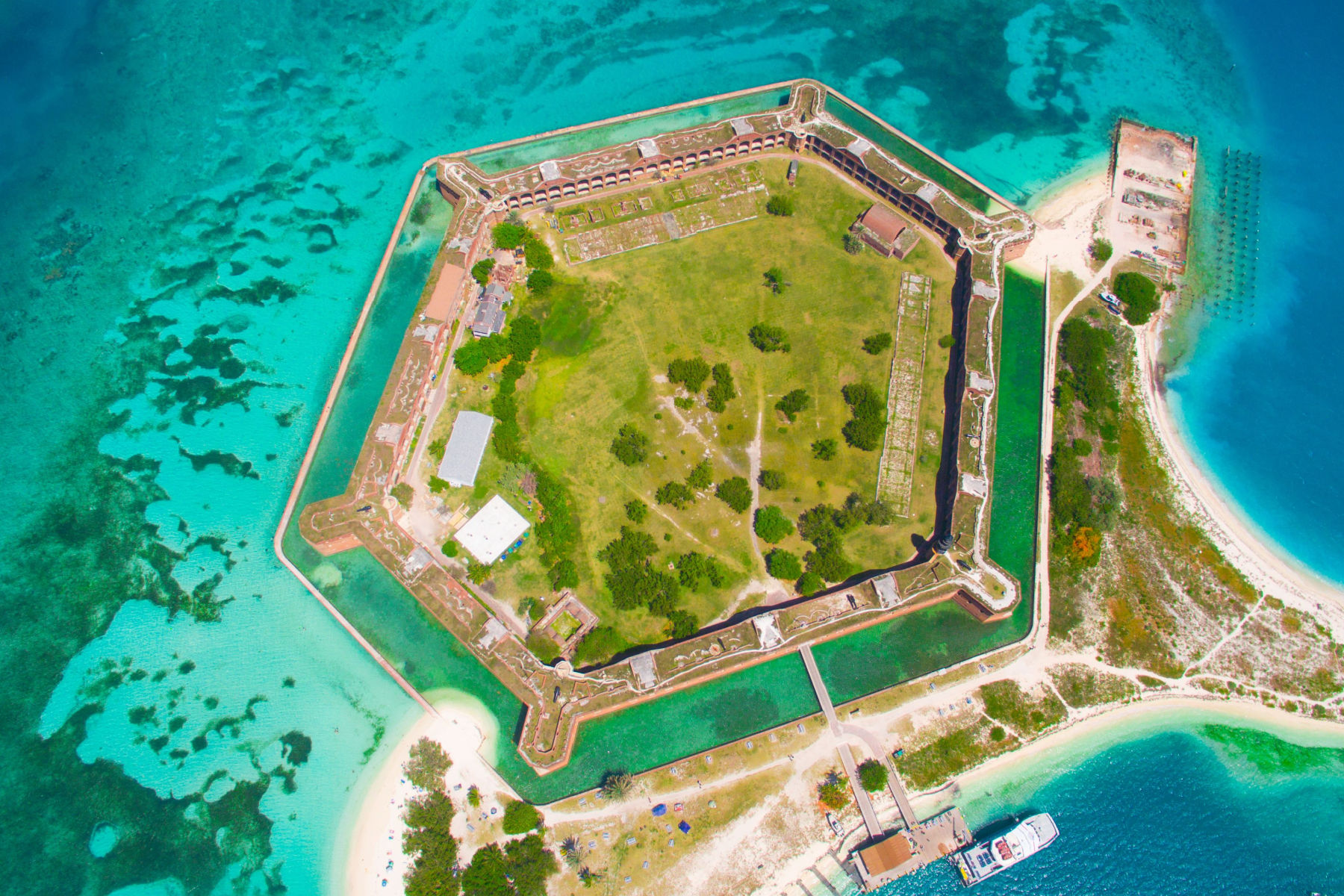
3. Walt Disney World
We’re on to our final 3 Florida landmarks. At #3 on our list of the Best Florida Landmarks is the largest Disney theme park in the world – larger than its park in California.
Welcome to Disney World in Orlando. It includes Epcot, Magic Kingdom Park, Disney’s Animal Kingdom Park, and Disney’s Hollywood Studios.
Walt Disney World is a world-renowned entertainment complex located in Bay Lake and Lake Buena Vista, Florida. The history of Walt Disney World begins in the mid-1960s when Walt Disney, the legendary animator and entertainment entrepreneur, began looking for a site to build a new theme park on the East Coast.
After scouting various locations across the country, Walt Disney and his team settled on Florida as the ideal location due to its warm climate, available land, and proximity to major transportation routes.
Construction on Walt Disney World began in 1967, and the complex opened to the public on October 1, 1971. The park consisted of Magic Kingdom, which featured many of the same attractions as the original Disneyland in California, including: Main Street, USA, Fantasyland, Adventureland, Tomorrowland, and Frontierland.
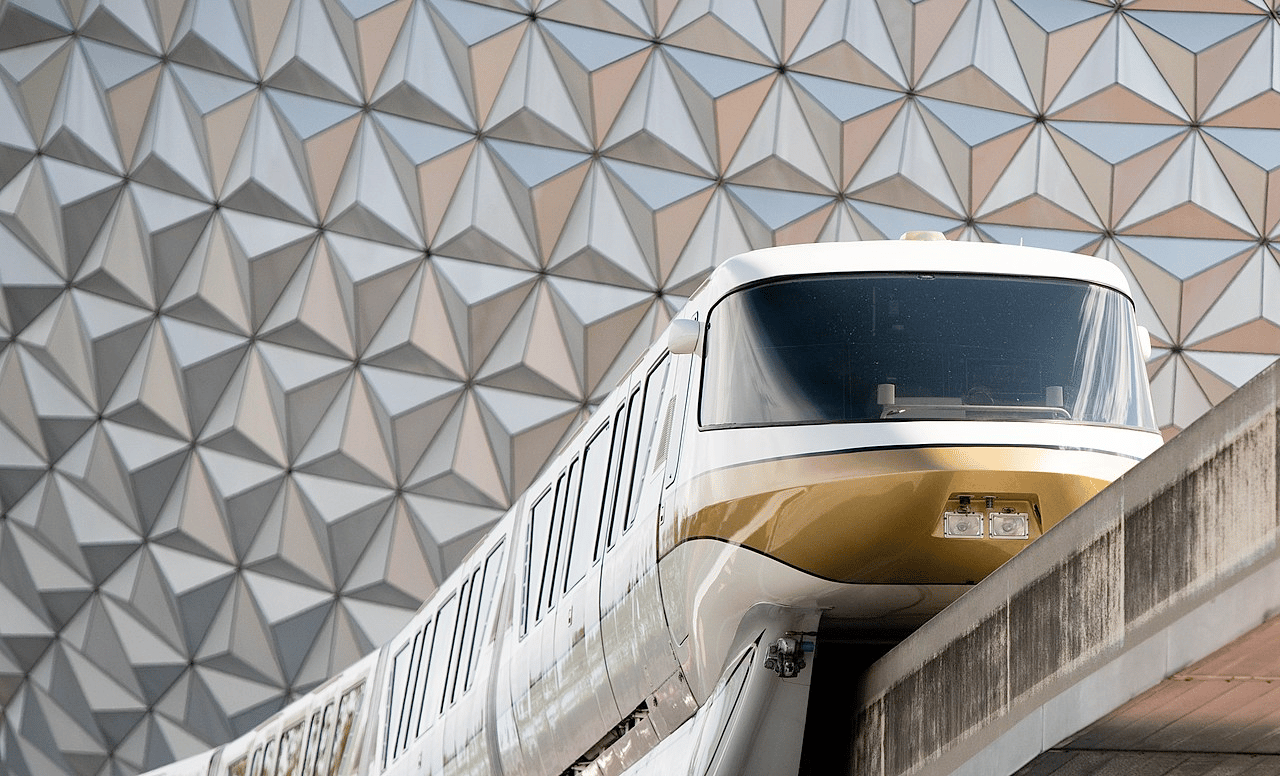
Over The Years, Walt Disney World Expanded To Include Additional Theme Parks
Over the years, Walt Disney World has expanded to include additional theme parks, including Epcot, Disney’s Hollywood Studios, and Disney’s Animal Kingdom, as well as a number of water parks, hotels, and other entertainment venues.
Walt Disney World has become one of the most popular tourist destinations in the world, attracting millions of visitors each year from around the globe. The complex has also had a significant impact on the local economy, creating jobs and driving tourism in the surrounding area.
Despite the death of Walt Disney in 1966, the company has continued to innovate and expand its offerings at Walt Disney World, ensuring that it remains a top destination for families, Disney fans, and entertainment enthusiasts for generations to come.

The Alameda Avenue entrance to the Walt Disney Studios in Burbank, California | Courtesy of Wikimedia Commons
Things To Do At Walt Disney World
When it comes to things to do at Walt Disney World there’s no shortage. Among my favorites are:
- Disney’s Animal Kingdom Theme Park
- Disney Springs
- Magic Kingdom Park
- Epcot
- Avatar Flight of Passage
- Pandora – The World of Avatar
- Disney’s Typhoon Lagoon Water Park
- Disney’s Blizzard Beach Water Park

100 Years of Disney on Display
Now if it’s history that you’ve come to see then how about the history of the man who brought joy to millions.
You can see 100 Years of Disney on Display. Originally opened to commemorate the 100th anniversary of Walt’s birth, the gallery showcases his life story from small-town America to Hollywood.
After your gallery tour, catch a screening of Walt Disney: One Man’s Dream, a 15-minute documentary that showcases the life and times of the visionary creator.
Featuring rare audio recordings, historical footage and rarely seen home movies, this film traces the dramatic tale of how Walt turned his dreams into reality.

2. Everglades National Park
We’re on to our final 2 Florida landmarks. In the runner-up spot at # 2 is a place that’s a World Heritage Site, a Biosphere Reserve, a Wetland of International Significance, and an Outstanding Florida Water.
It’s home to thirteen endangered and ten threatened species. It has the largest mangrove ecosystem in the western hemisphere and is the largest designated wilderness in the eastern U.S.
At #2 on our list of the Best Florida Landmarks is Everglades National Park.
Everglades National Park’s history dates back to the early 1900s, when local conservationists and environmentalists became concerned about the destruction of the region’s fragile ecosystems due to land development and agriculture.
In the 1920s and 1930s, efforts to preserve the Everglades began in earnest, with the formation of the Everglades Tropical National Park Association and the purchase of land for conservation purposes.
In 1934, President Franklin D. Roosevelt signed an executive order establishing Everglades National Park, making it one of the first national parks to be created solely to protect a unique ecosystem. The park was officially dedicated in 1947.
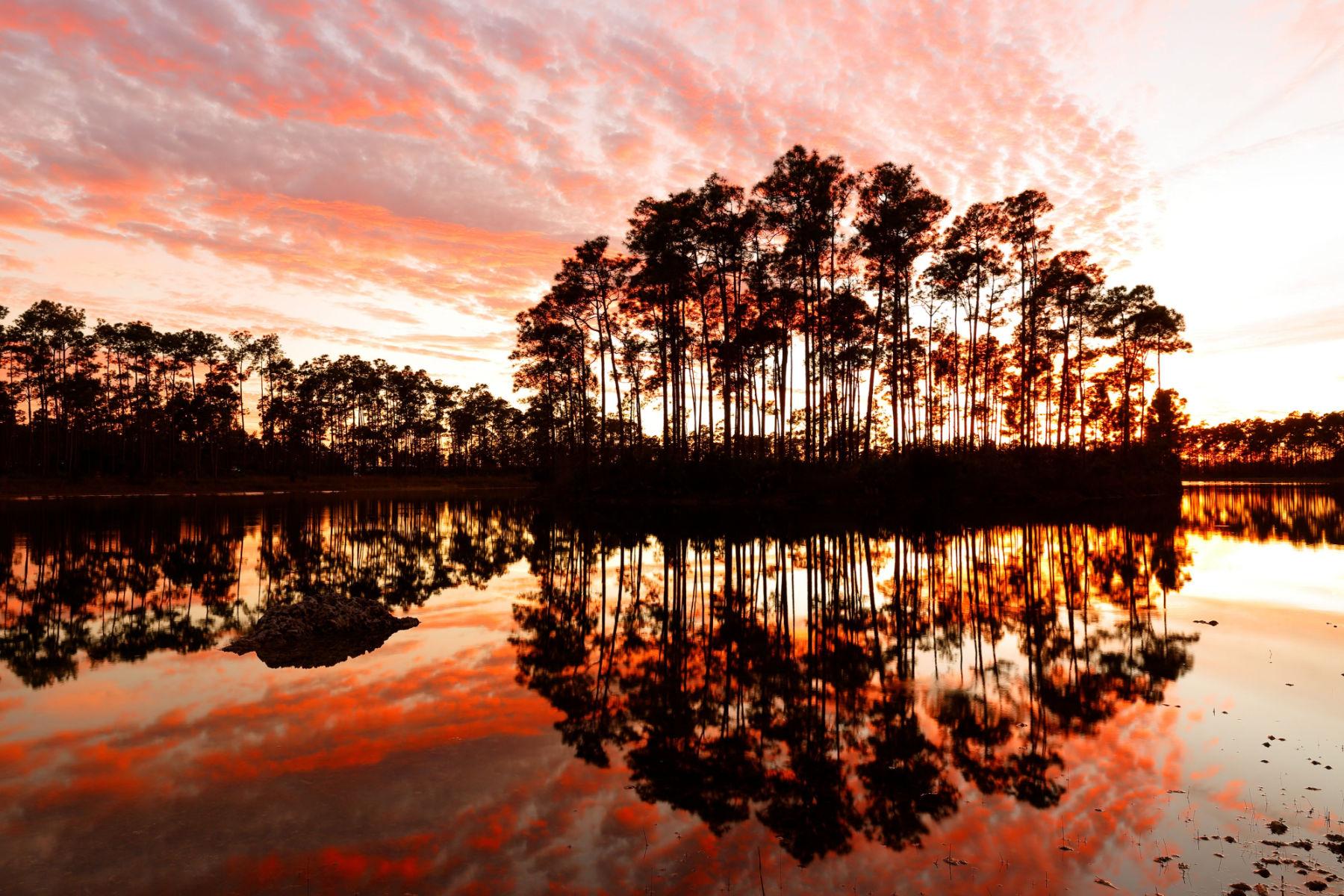
The Park Has Faced Many Challenges
Over the years, the park has faced many challenges, including hurricanes, droughts, and invasive species. In the 1950s and 1960s, the construction of the Tamiami Trail, a major roadway that bisects the park, caused significant environmental damage by disrupting the flow of water in the Everglades.
Efforts to restore the park’s natural ecosystems and protect its wildlife have been ongoing. In 2000, Congress passed the Comprehensive Everglades Restoration Plan, a multi-billion dollar effort to restore the natural flow of water to the Everglades and protect the park’s delicate ecosystem.
Today, Everglades National Park is a popular destination for visitors from around the world, who come to explore its unique wetlands, see its diverse wildlife, and learn about the park’s history and conservation efforts. The park remains a vital part of Florida’s ecosystem and a testament to the importance of protecting the natural world for future generations.
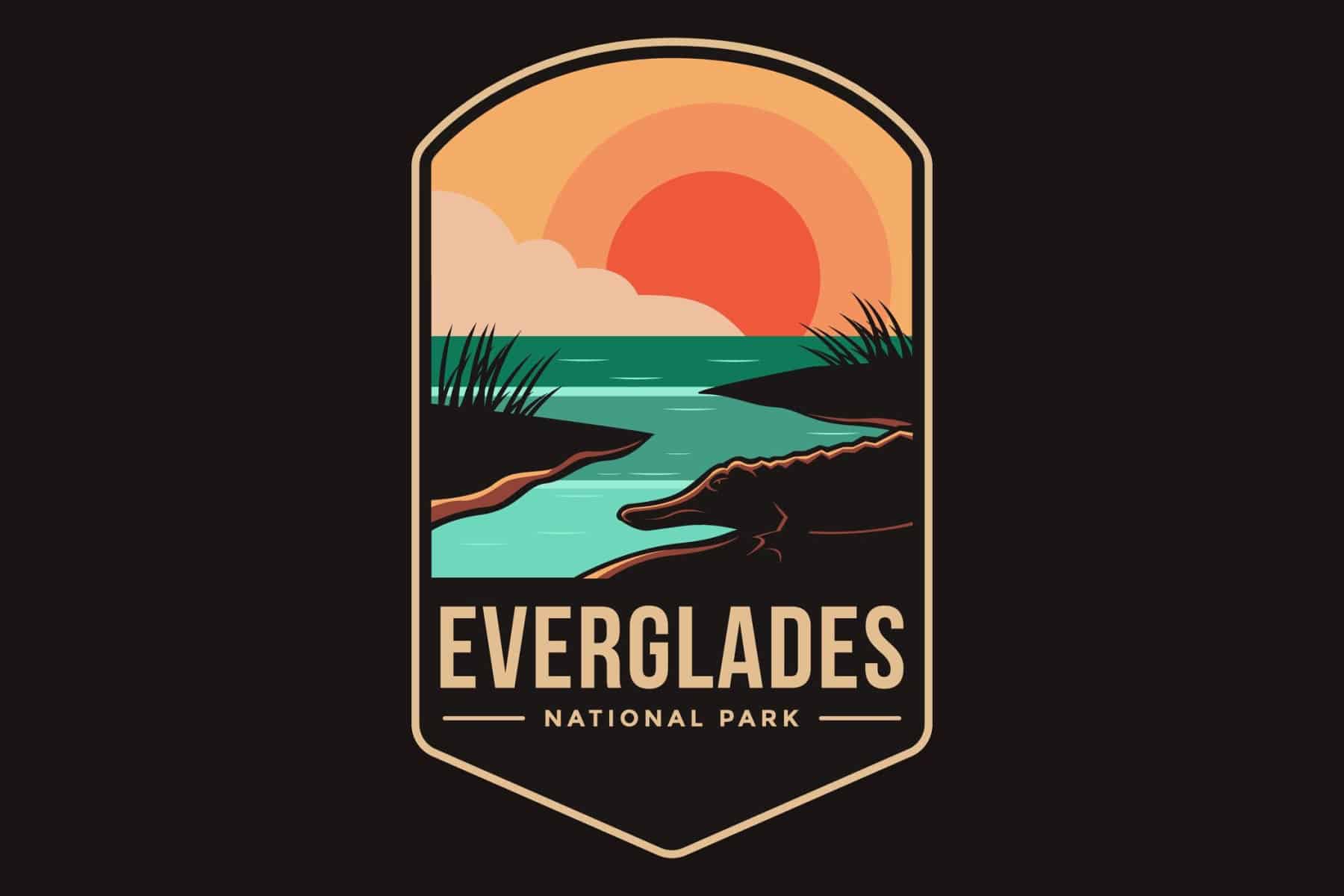
Best Things to Do at Everglades National Park
Anhinga Trail is the “can’t miss” hike of Everglades National Park. The trail itself is only .8 miles long but is quintessential Everglades with a boardwalk, gators, the whole deal.
Fan Boat Tour – Everglades is best viewed by water and there’s no way to cover more ground by water than a classic fan boat ride through the park.
Wildlife Viewing While alligators may be a crowd favorite the Everglades are absolutely teeming with wildlife including some of the best bird watching in the world.
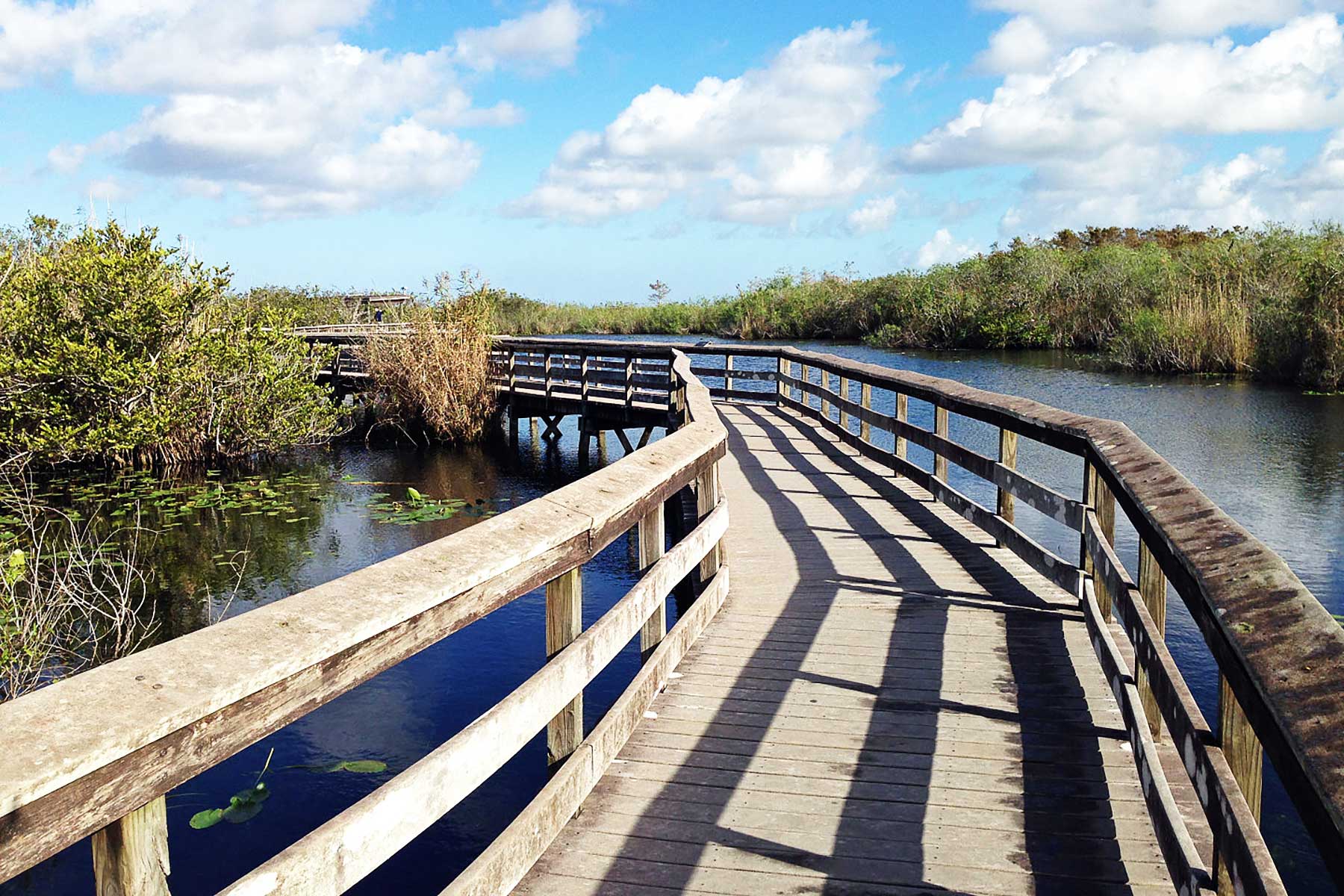
Camping in Everglades
There’s only two drive-able campgrounds in Everglades National Park. Both are accessed via the Homestead entrance of the park and managed by a third party outfit (not the park service).
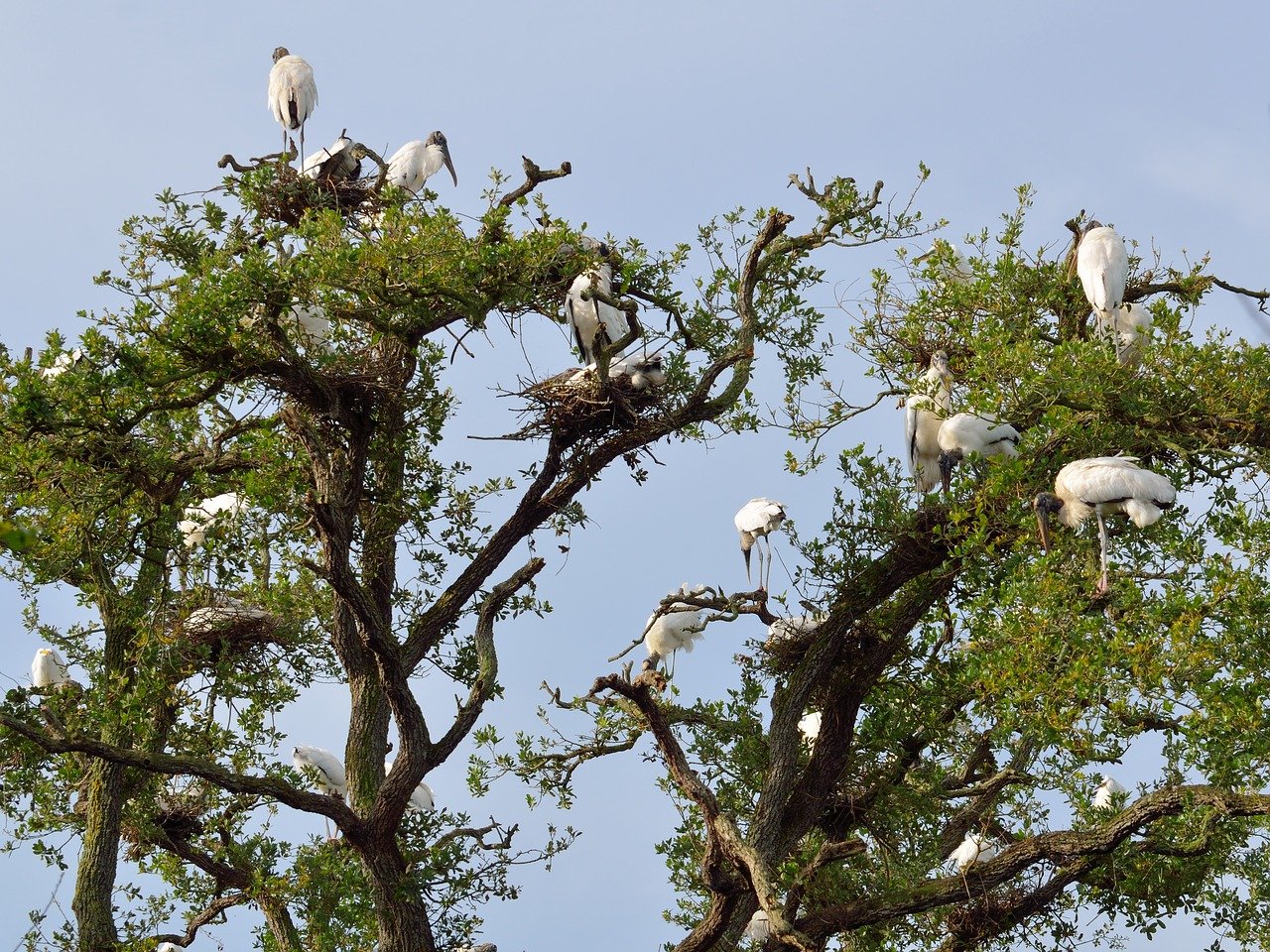
Wilderness Camping
There is an abundance of Wilderness camping opportunities at Everglades National Park. A popular option is kayak camping through the everglades.
To do this, you must fill out a wilderness permit in advance of your trip which can be done through recreation.gov.
Lodging
In the nearby town of Homestead (mere minutes from the park entrance) there are a plethora of lodging options including:
1. Kennedy Space Center
As the #1 Florida Landmark, More Than Just Parks has selected the Kennedy Space Center. The Kennedy Space Center in Florida is pivotal in NASA’s mission. It is the base for Space Shuttle launch and landing operations.
Every manned mission to space has departed from NASA Kennedy Space Center. Over the years, it has evolved to become the starting point for hundreds of scientific and applications spacecraft.
The history of the Kennedy Space Center begins in the late 1940s, when the U.S. government began to search for a location to establish a launch site for rockets and missiles.
In 1949, the government chose a location on the east coast of Florida, near Cape Canaveral, for the launch site. The area was chosen because of its proximity to the equator, which provides a natural boost to rockets launched from that location.
In 1958, NASA was established as a response to the Soviet Union’s launch of the first artificial satellite, Sputnik. One of NASA’s first tasks was to establish a launch site for its rockets and spacecraft.
NASA chose Cape Canaveral as the site for its space program, and the facility was renamed the John F. Kennedy Space Center in honor of the late president in 1963, shortly after his assassination.
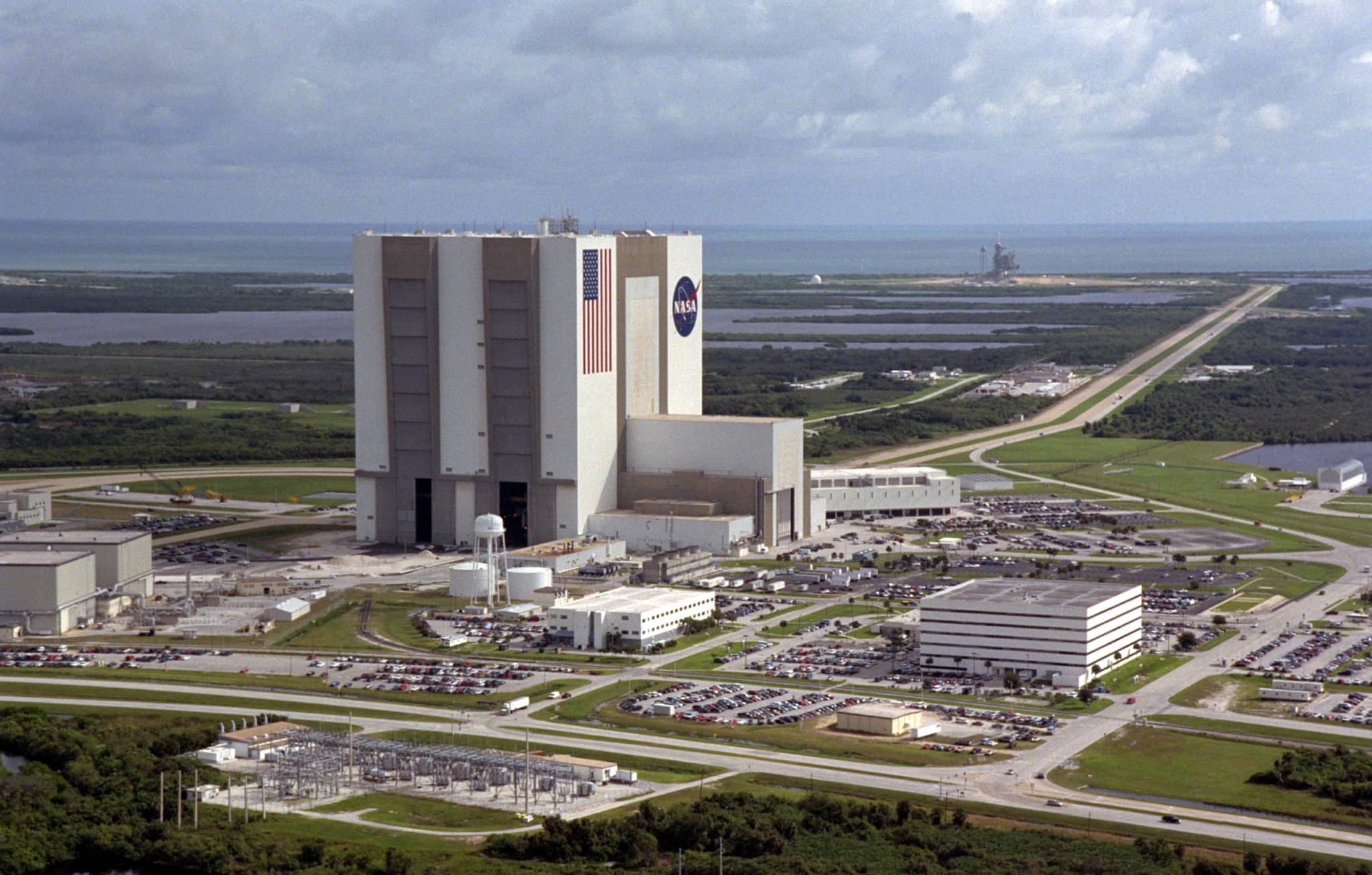
Project Apollo
The first launch from the Kennedy Space Center was the unmanned Apollo 4 mission in November 1967. The center was then used extensively for the Apollo program, which culminated in the first manned moon landing in July 1969.
The center also supported numerous other manned and unmanned space missions throughout the 1970s and 1980s, including the Skylab space station, the Space Shuttle program, and the International Space Station.
The Kennedy Space Center has been involved in many historic space missions, including the launch of the first American in space, the first moon landing, and the first space shuttle mission. The center has also been used for commercial launches and is an important part of the American space program.
In recent years, the Kennedy Space Center has been undergoing a transformation to adapt to new developments in space technology and exploration.
In 2020, NASA partnered with private companies like SpaceX to launch astronauts from the United States for the first time in almost a decade, signaling a new era of collaboration between NASA and the private sector.
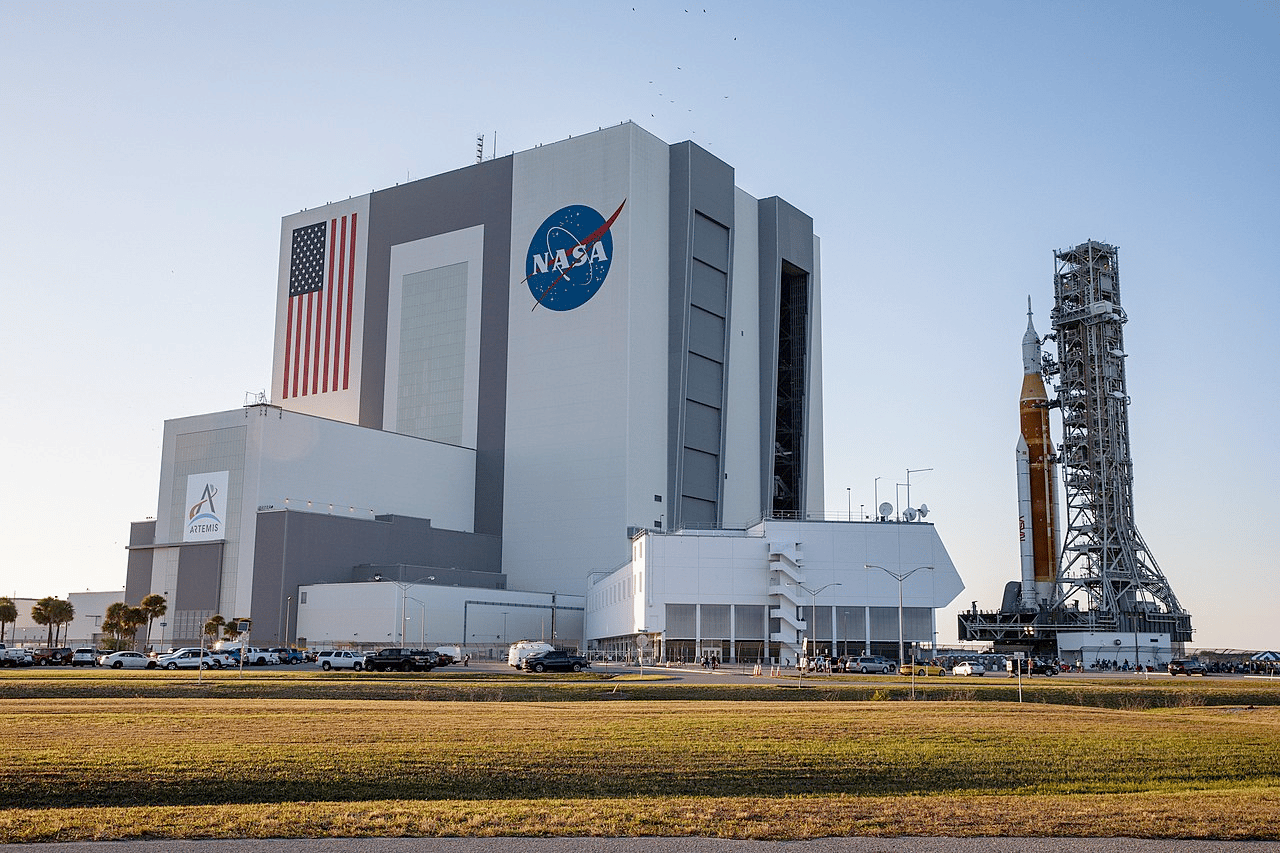
Things To Do At The Kennedy Space Center
From the Visitor Center there’s much to see and do. Attractions include:
- U.S. Astronaut Hall of Fame
- Mission Control: The Unsung Heroes of Apollo. Heroes & Legends.
- Rocket Garden. Heroes & Legends
- Astronaut Encounter. Heroes & Legends.
- Heroes & Legends
- Kennedy Space Center Bus Tour
- Apollo 8 and the Firing Room
- Path to the Moon
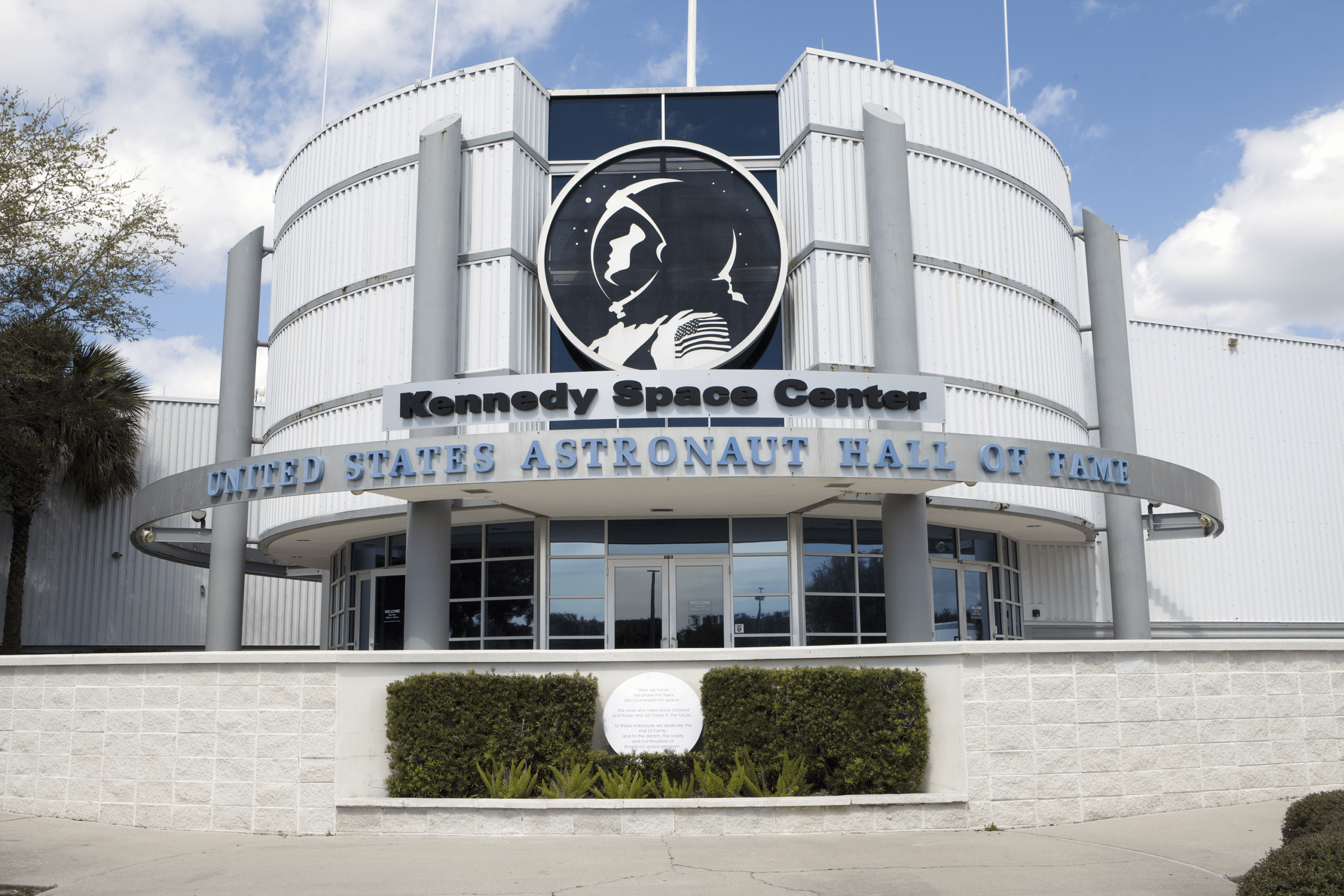
Map Of Florida Landmarks
List Of Florida Landmarks
- Kennedy Space Center
- Everglades National Park
- Walt Disney World
- Fort Jefferson in the Dry Tortugas
- Miami Beach
- Fernandina Beach on Amelia Island
- Dry Tortugas National Park
- Tampa Zoo
- Timucuan Ecological & Historic Preserve
- Nike Missile Base in Everglades National Park
- Fort Matanzas National Monument
- Art Deco Historic District
- Ponce de Leon Inlet Lighthouse & Museum
- Castillo de San Marcos National Monument
- Gulf Islands National Seashore
- De Soto National Memorial
- Fort Caroline National Memorial
- Pelican Island National Wildlife Refuge
- Key West Lighthouse
- Kingsley Plantation
- Vizcaya Museum & Gardens
- The Ernest Hemingway Home & Museum
- Okeechobee Battlefield State Historic Park
- Lightner Museum
- Fort King National Historic Landmark
Why Trust Us About Florida Landmarks?
We’re Jim Pattiz and Will Pattiz, collectively known as the Pattiz Brothers and we absolutely LOVE the national parks.
You should probably know that we don’t just make this stuff up out of thin air. We’ve spent our entire adult lives exploring and filming America’s national parks and public lands.
We’ve worked with the National Park Service, the Department of Interior, USDA, U.S. Forest Service, and more for years creating films on important places and issues. Our work has been featured in leading publications all over the world and even some people outside of our immediate family call us experts on the national parks.
And, in 2018, our father – having spent a lifetime teaching history – joined us so that he could help us to tell the stories behind these amazing places.
Meet The Parks Brothers
We Hope You’ll Follow Our Journey

Our goal here at More Than Just Parks is to share the beauty of America’s national parks and public lands through stunning short films in an effort to get Americans and the world to see the true value in land conservation.
We hope you’ll follow our journey through the parks and help us to keep them the incredible places that they are. If you’re interested in joining the adventure then sign up below!
Helpful Related Articles
Overseas Highway Road Trip: Miami to Key West Drive: Everything You Need to Know
Best East Coast National Parks: Top 10 Best East Coast National Parks Ranked
National Parks Ranked: ALL 63 US NATIONAL PARKS RANKED By Experts
Most Visited National Parks: Top 10 Most Visited US National Parks
Georgia National Parks: 10 Amazing Georgia National Parks Worth Visiting
South Carolina National Parks: 8 Epic South Carolina National Parks Worth Visiting
National Parks Road Trip: 10 EPIC National Parks Road Trips (Expert Guide)
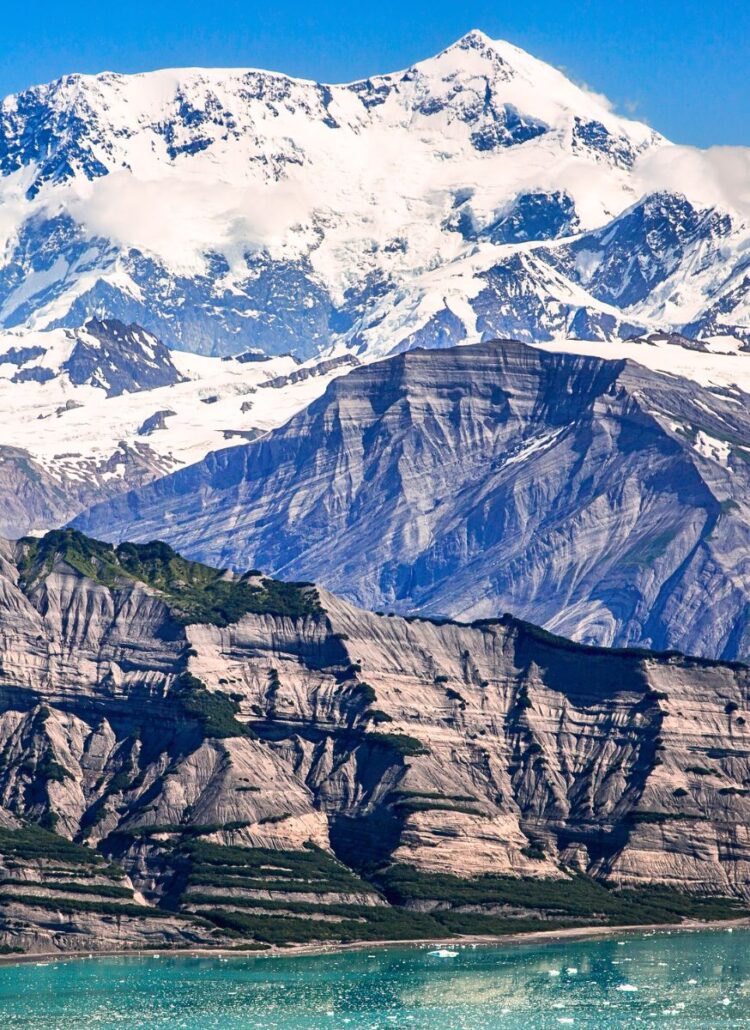
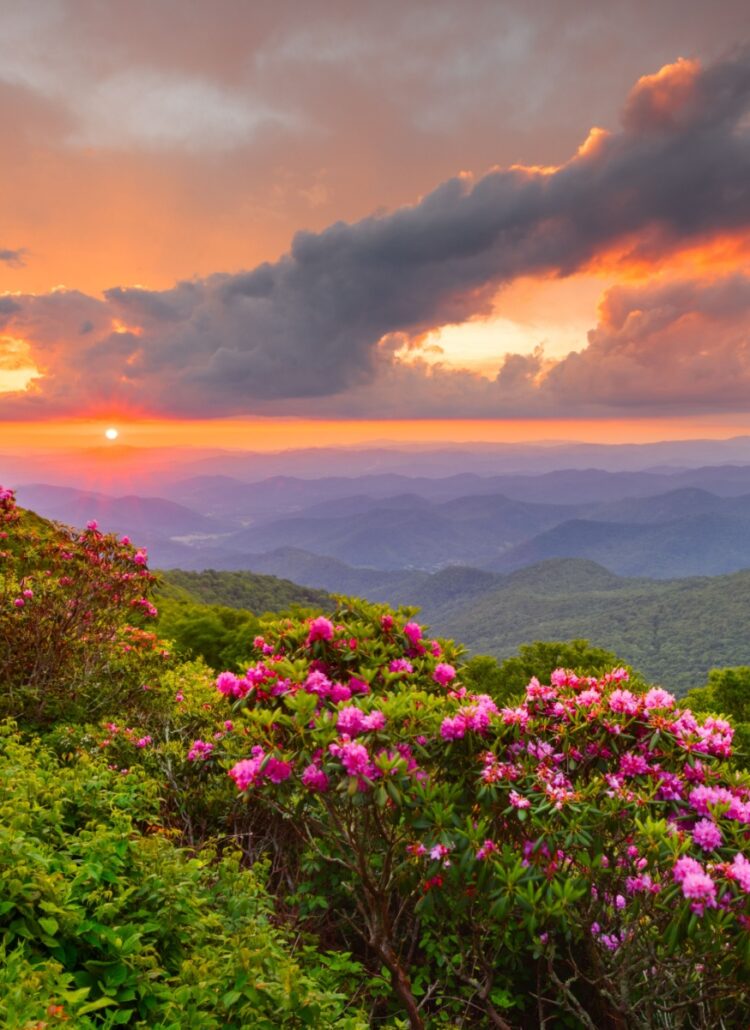
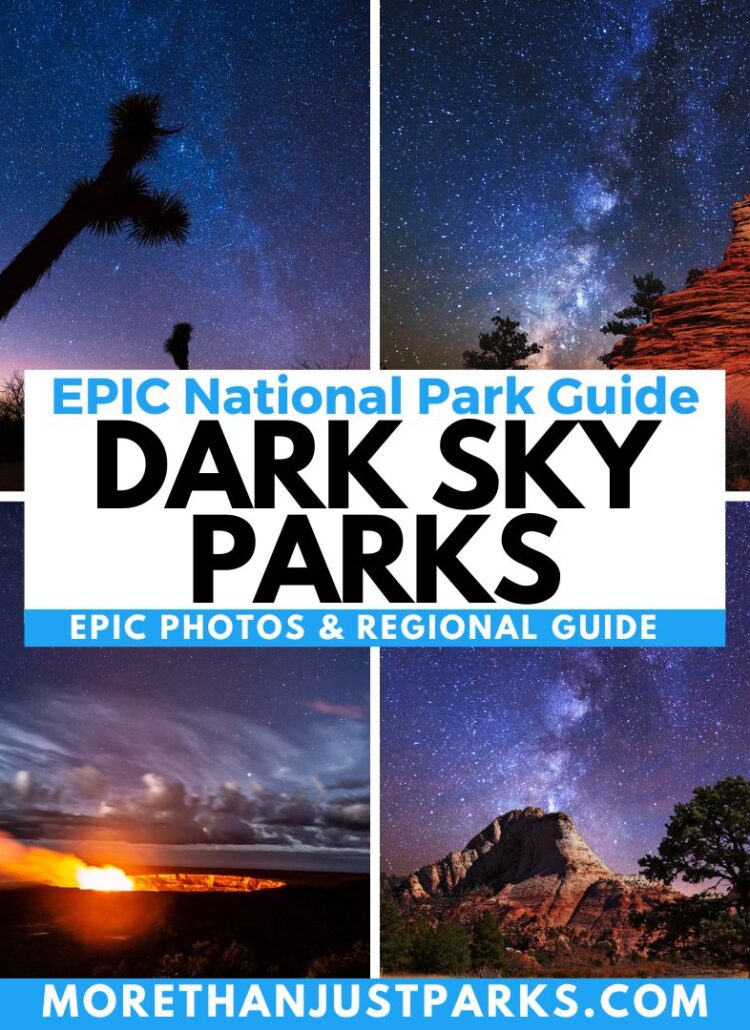
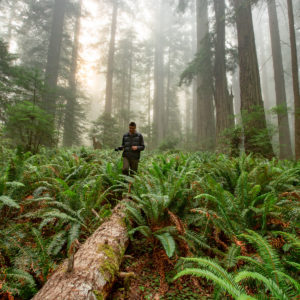

Leave a Reply